It was time to take our trip “up north” to Venice and Cinque Terre. I’d been to both before (in 2001) but Michael hadn’t been to either. I didn’t have specific memories of either place, but I had a warm fuzzy feeling that made me excited to see them again.
We’d headed to Agropoli a couple of days prior to catching the train to Venice. They have a marina that is less expensive than those along the Amalfi Coast. We needed to be in a marina for a couple of reasons: 1) we don’t leave Seahike at anchor when we go out of town for safety reasons, and 2) we were having a repaired battery charger and four new solar panels delivered to Seahike and needed a real-live address to do so.
We didn’t spend much time in Agropoli, but it seemed to be a nice city. The train station was a bit of a hike, so we were glad we didn’t have a lot of heavy luggage to carry.
We arrived with about 10 minutes to spare, only to learn that the train was 10 minutes late. We went to the correct track to board the train then proceeded to get lost in our phones. All of a sudden, Michael looked up from his phone and asked where everyone was. It was then that we realized that the train was arriving on a different track than where we were standing. And the train was already there! We went into panic mode and I tried to ask someone how to get to the track on the other side. He didn’t speak English. Michael said, “he doesn’t understand you,” and we took off. We saw the stairs that led to the underground passage. When we reached the bottom, several people exiting the train pointed to where we needed to go. We sprinted up the stairs to the train and boarded. We’d only been on the train about 30 seconds when the doors closed. Whew!
So, that was exciting.
We’d started the trip on a regional train, then changed to a high-speed train in Salerno. The rest of the seven-hour trip was thankfully uneventful.
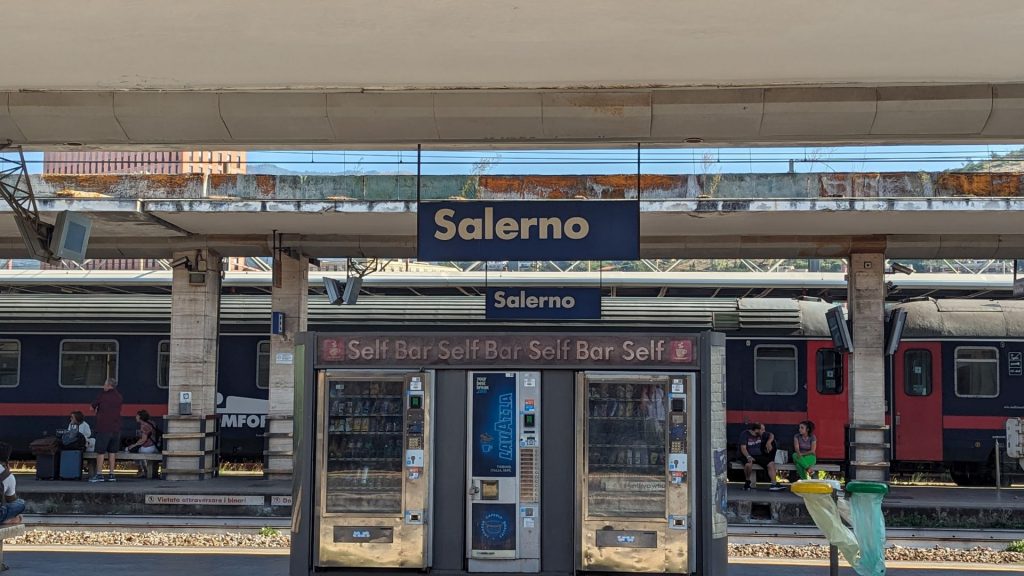
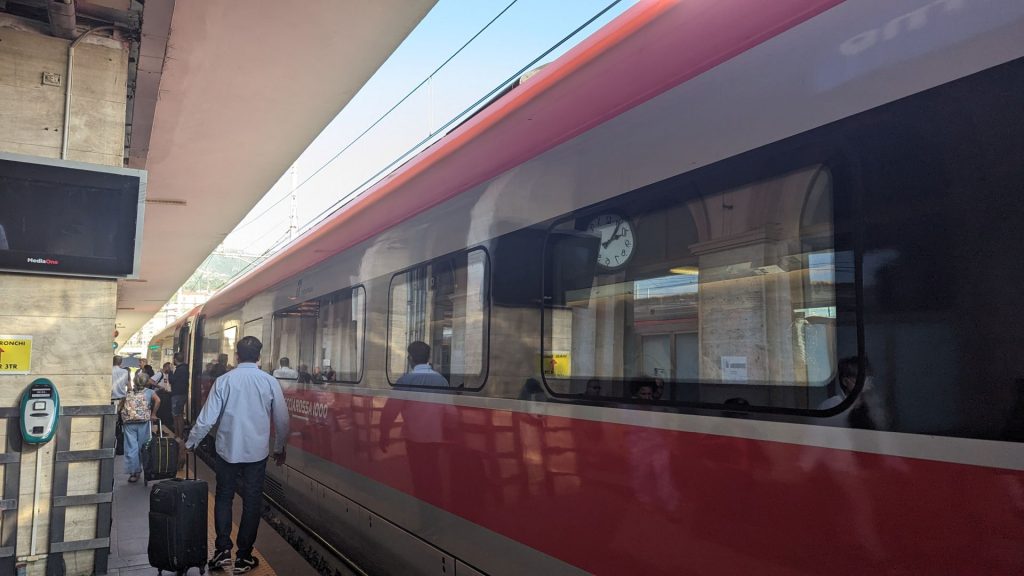
When we arrived in Venice, we were greeted with this sight. I immediately felt like I’d come home to an old friend. It was so exciting!
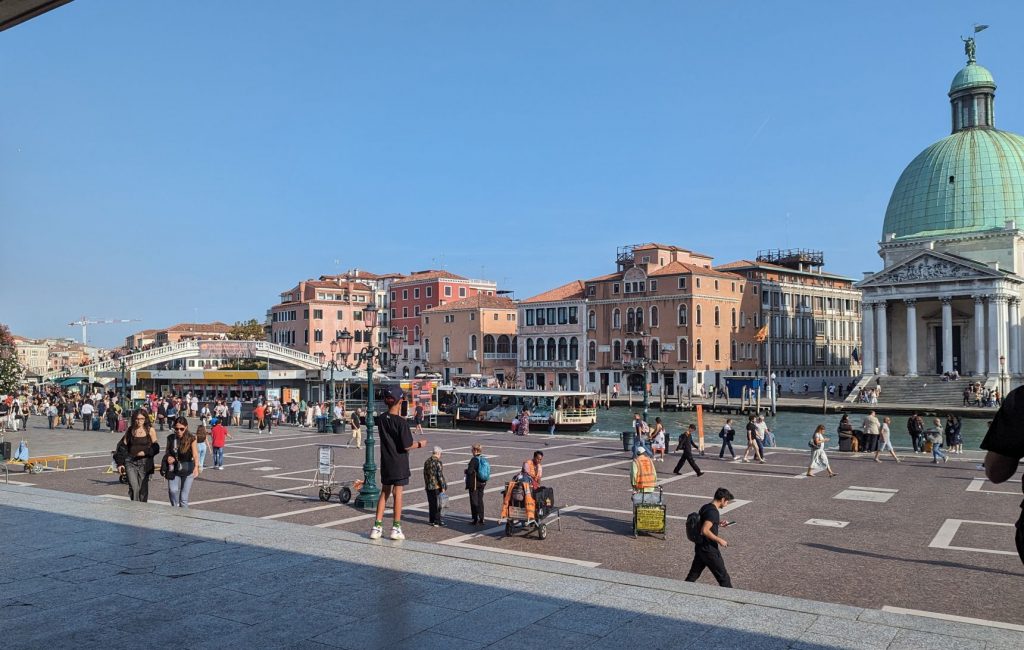
We bought a ticket for the waterbus (definitely the way to travel – inexpensive and quick!) and started to enjoy the scenery along the Grand Canal.
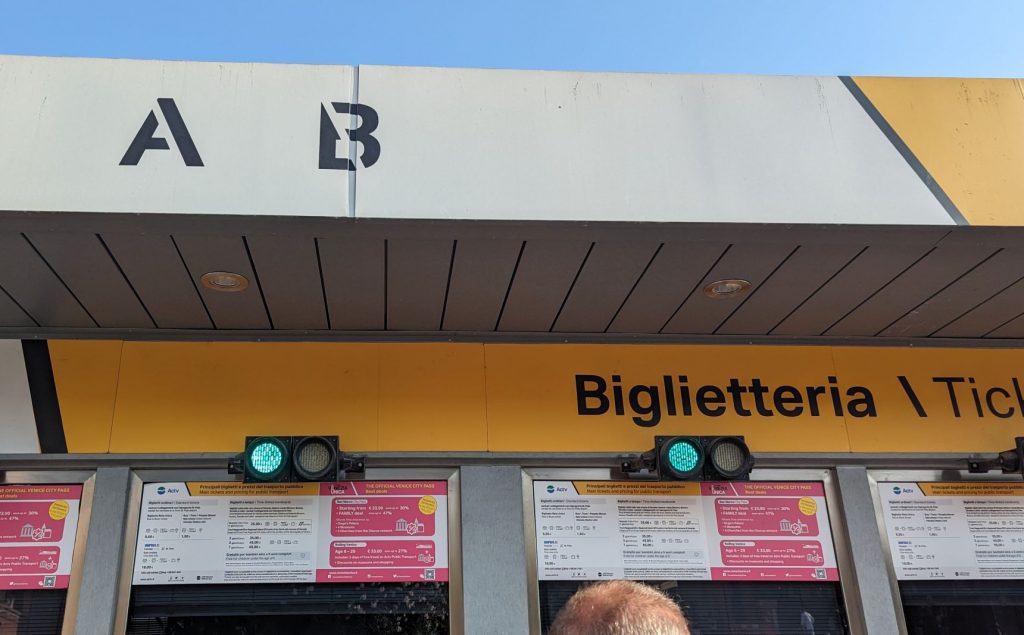
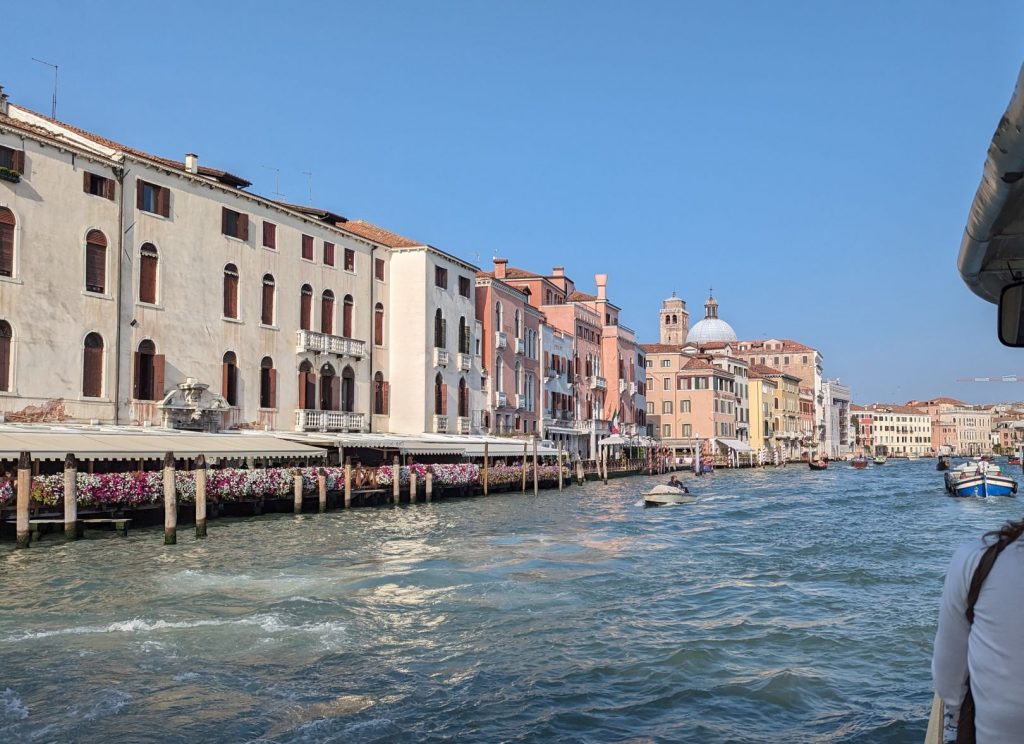
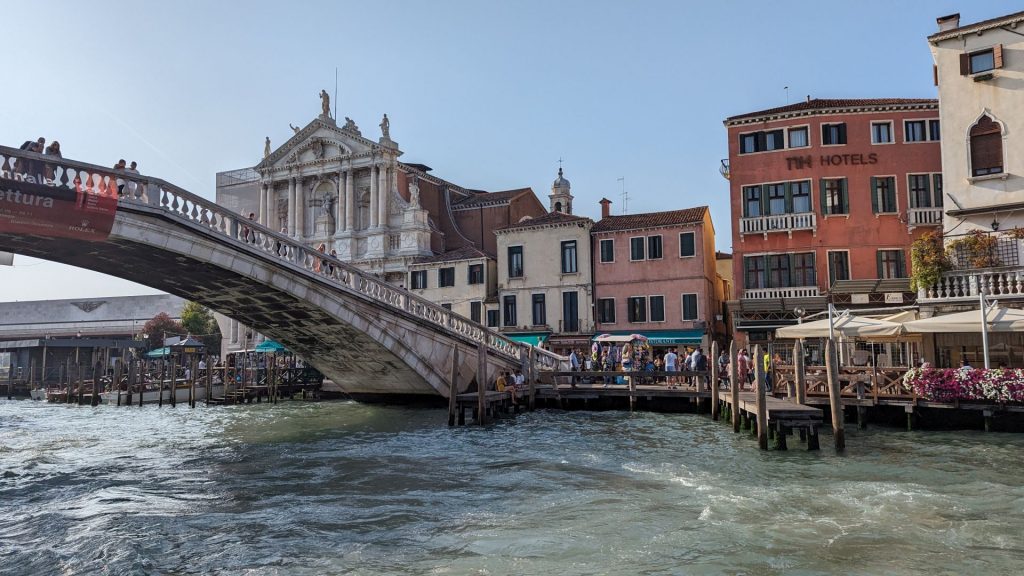
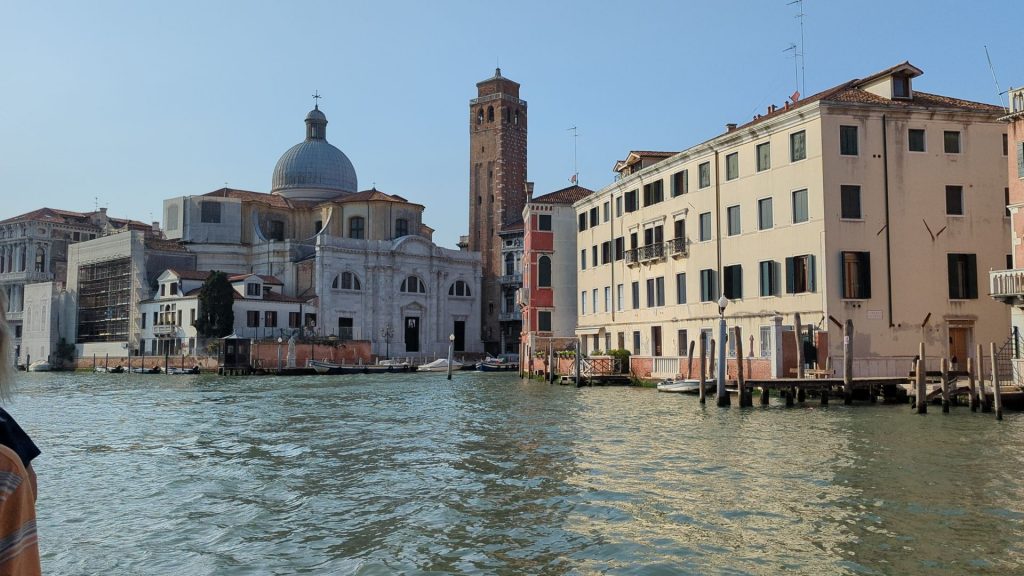
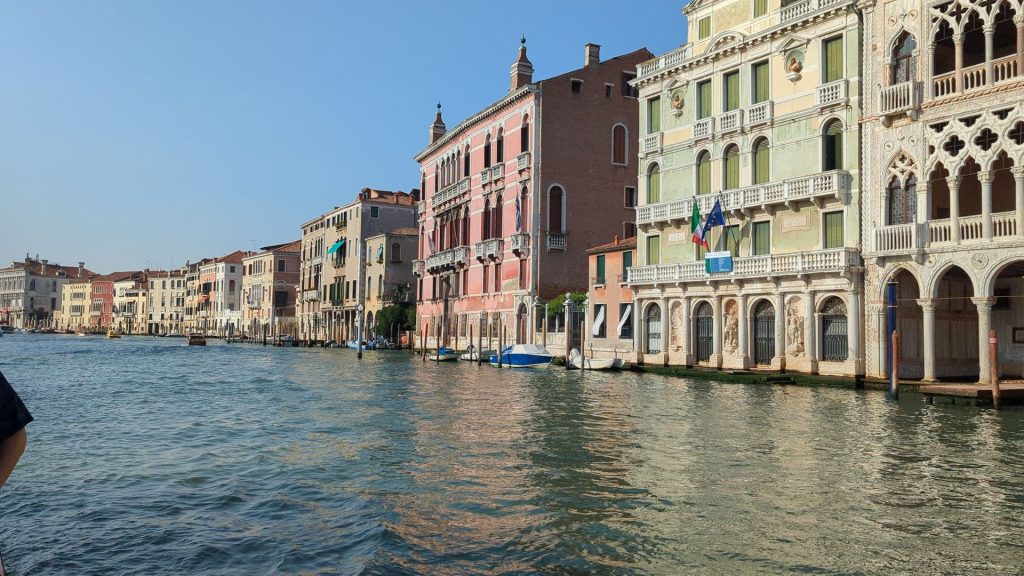
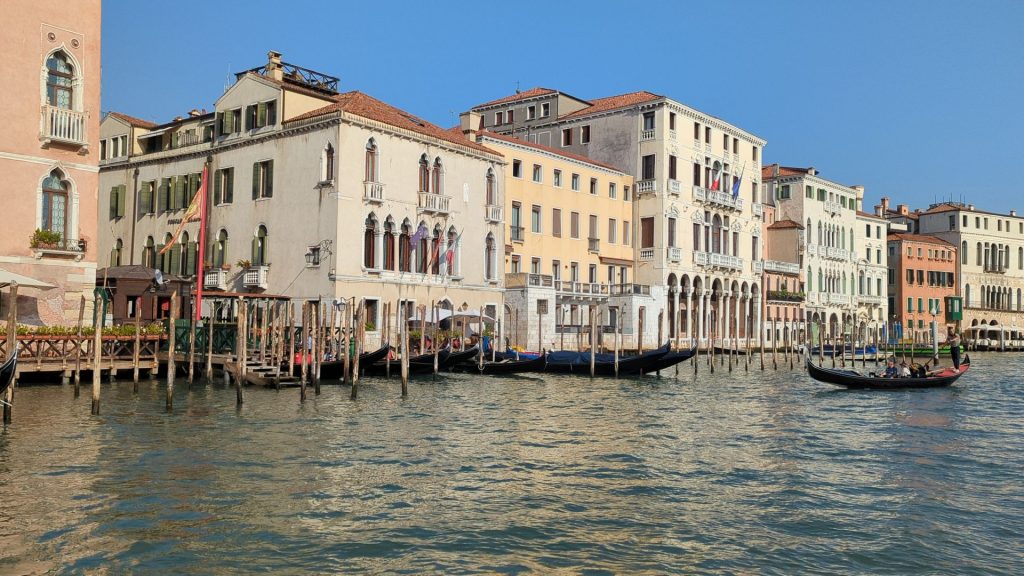
We exited the waterbus at the Rialto Bridge and walked the short distance to the hotel we were told to go to where they would assign someone to take us to our actual hotel.
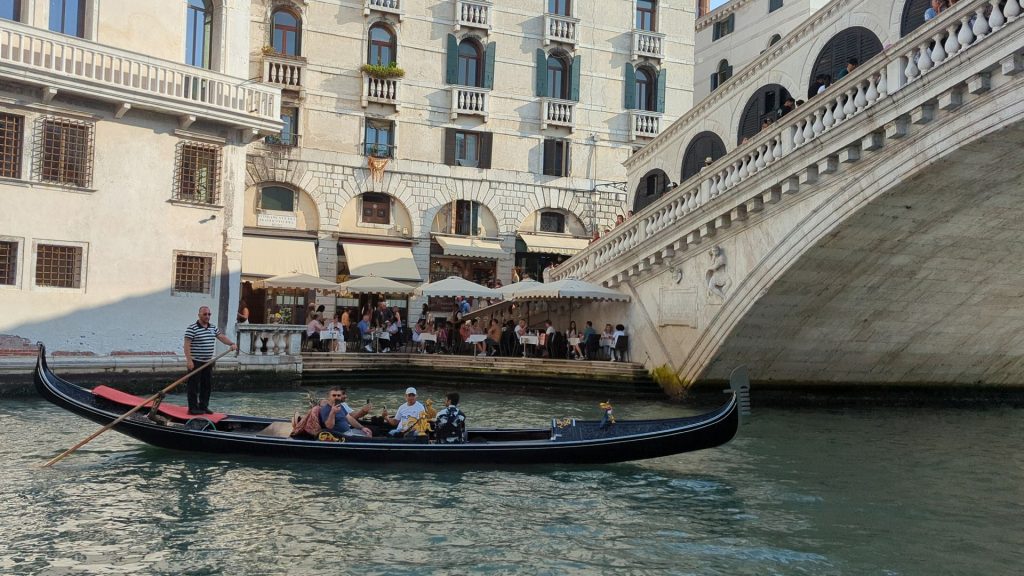
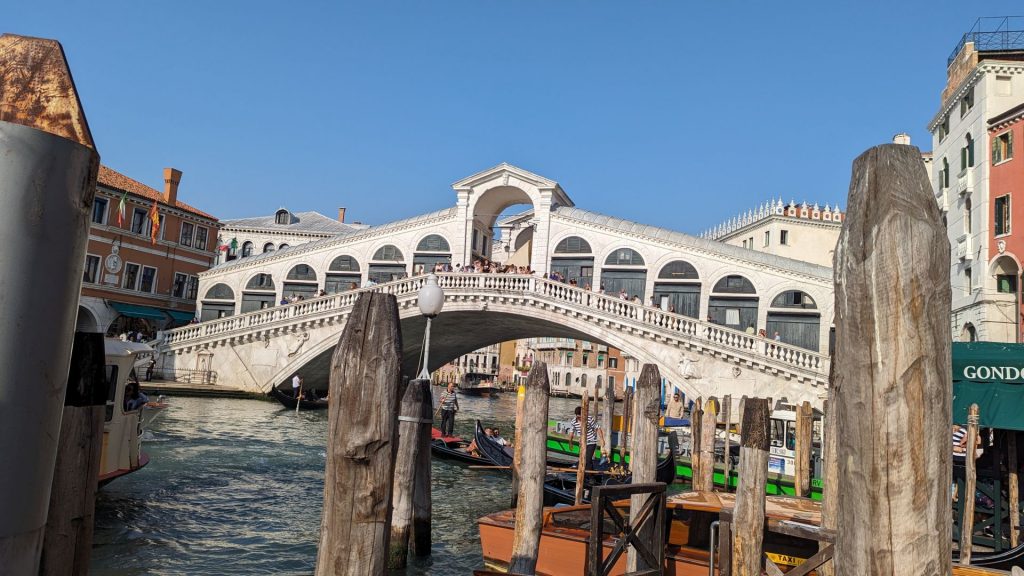
We then followed the guide to our hotel room. The hotel itself was nearly invisible – just a nondescript door on a street filled with restaurants and shops. The walk to the hotel was through many narrow streets. We would have had a difficult time finding it without our guide!
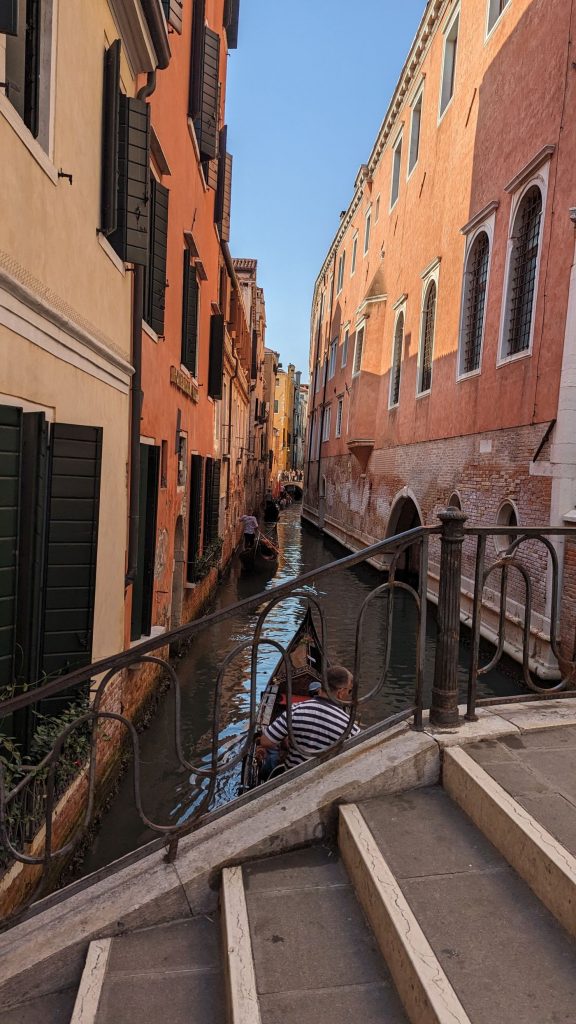
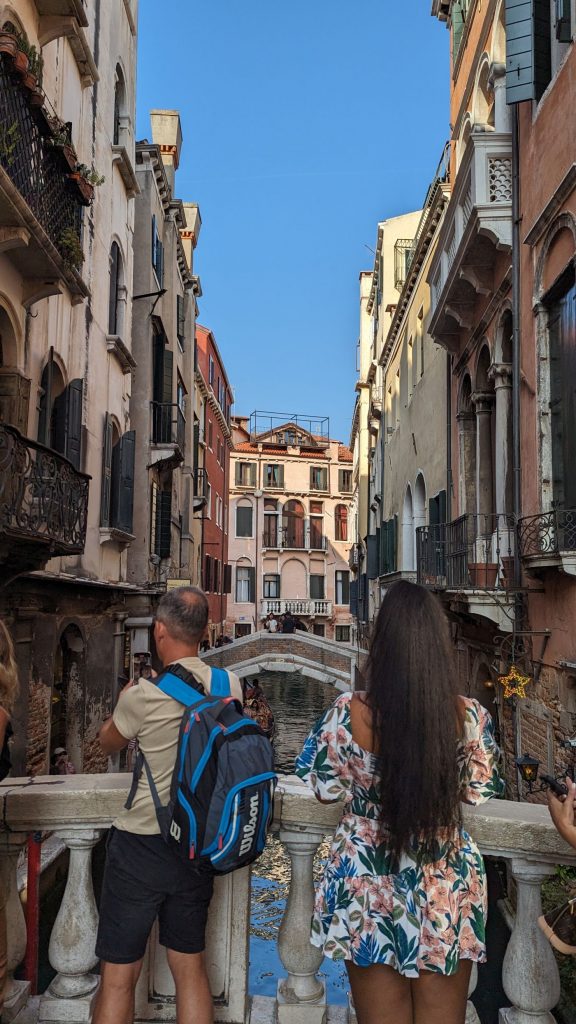
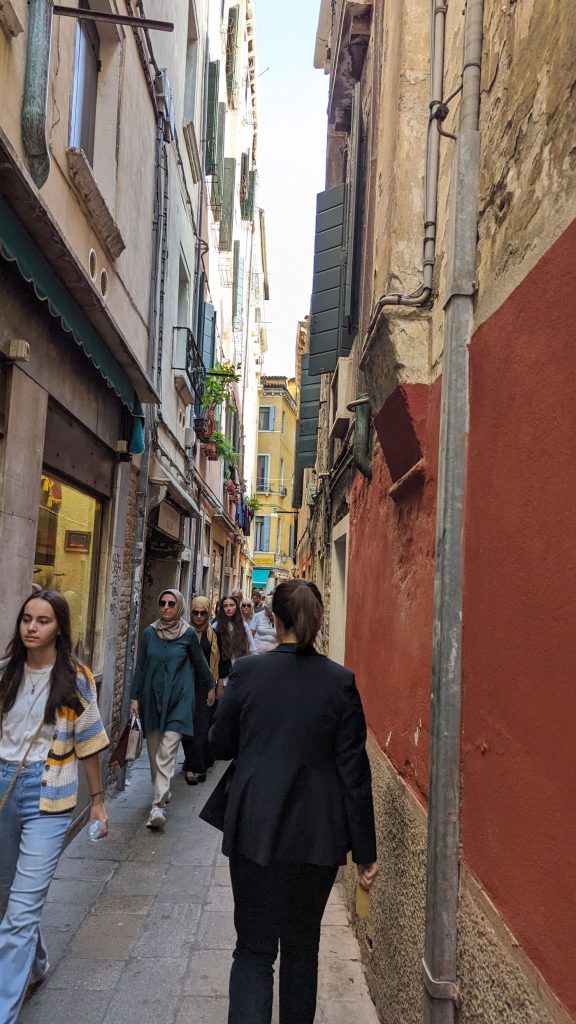
The hotel was nearly vacant. Very weird. We were given three keys for the various doors we needed to open to get to our room. When we made it, we were struck by the. . . redness! 🙂
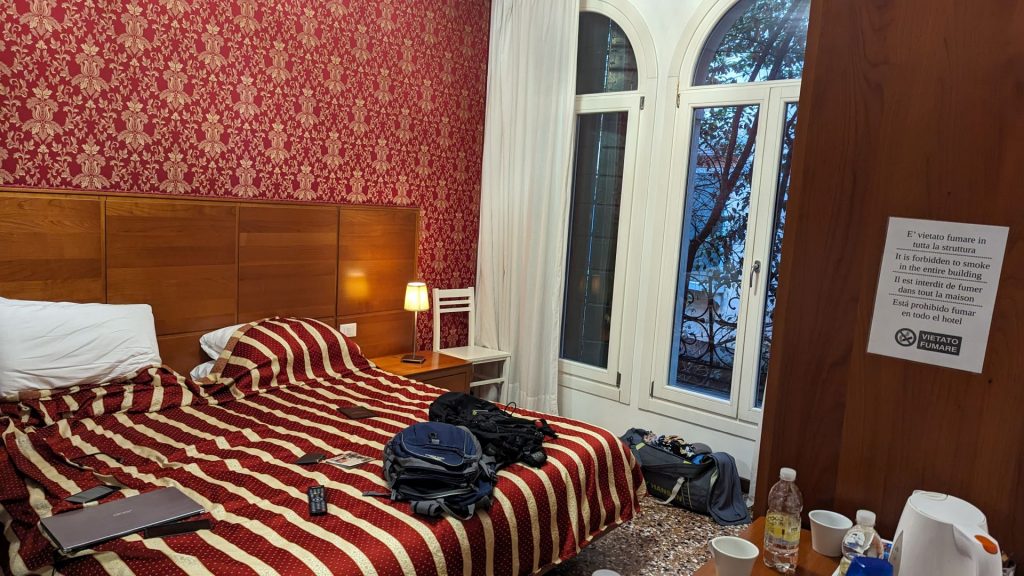
It had been a bit of a long travel day, but we still had the entire evening ahead of us and we’d filled it with plans.
We arrived at St. Mark’s square as the sun was getting lower in the sky. You can watch the sun go down as our pictures progress.
After visiting the square, we took the lift to the top of the Campanile (bell tower of the Basilica). According to Google, it was closed, but we stopped by anyway, only to discover that it was open. We met two couples from Florida while visiting the Campanile. These were just four of the many Americans we’d meet in Venice and Cinque Terre. We hadn’t seen this many Americans in our entire travels!
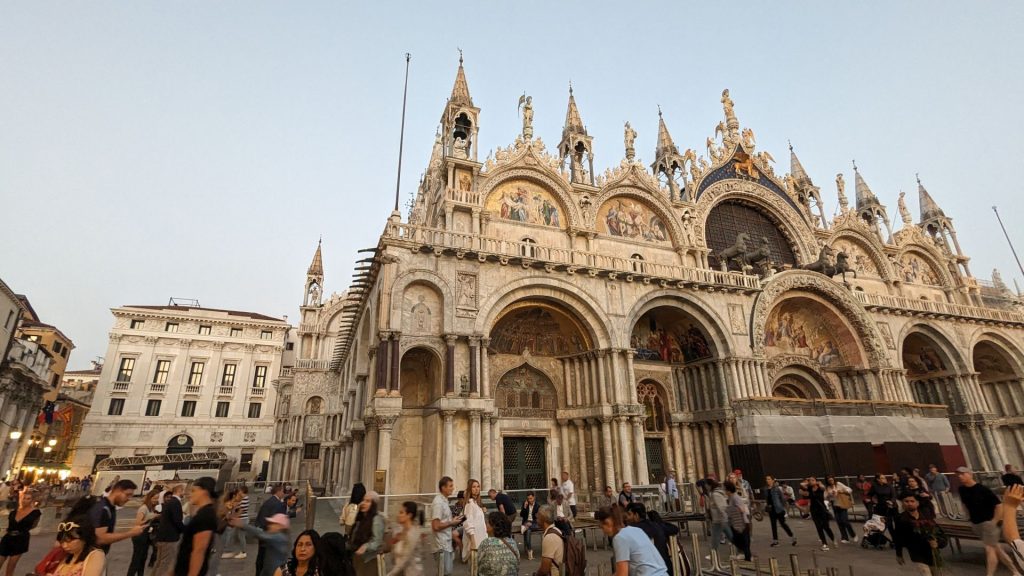
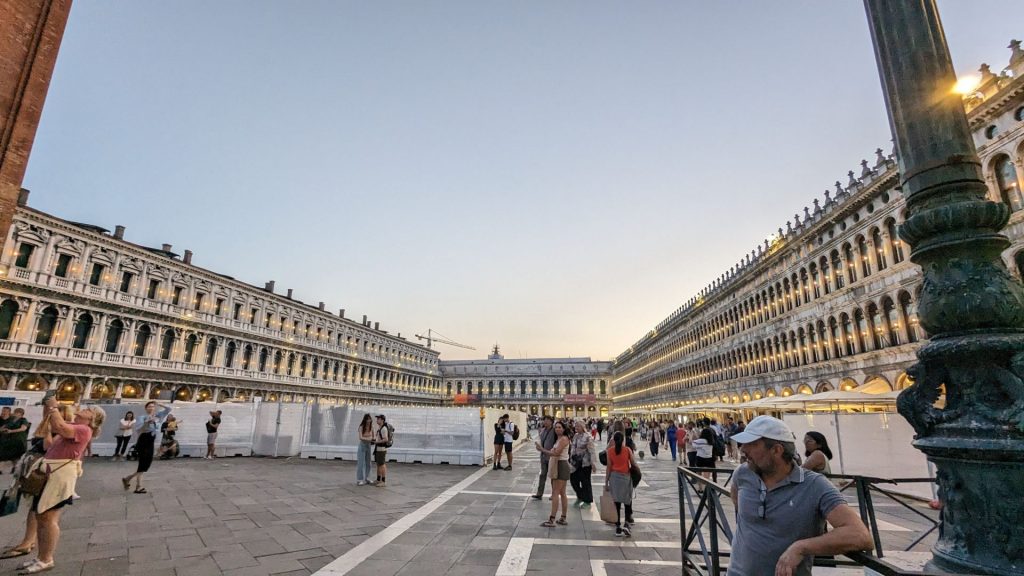
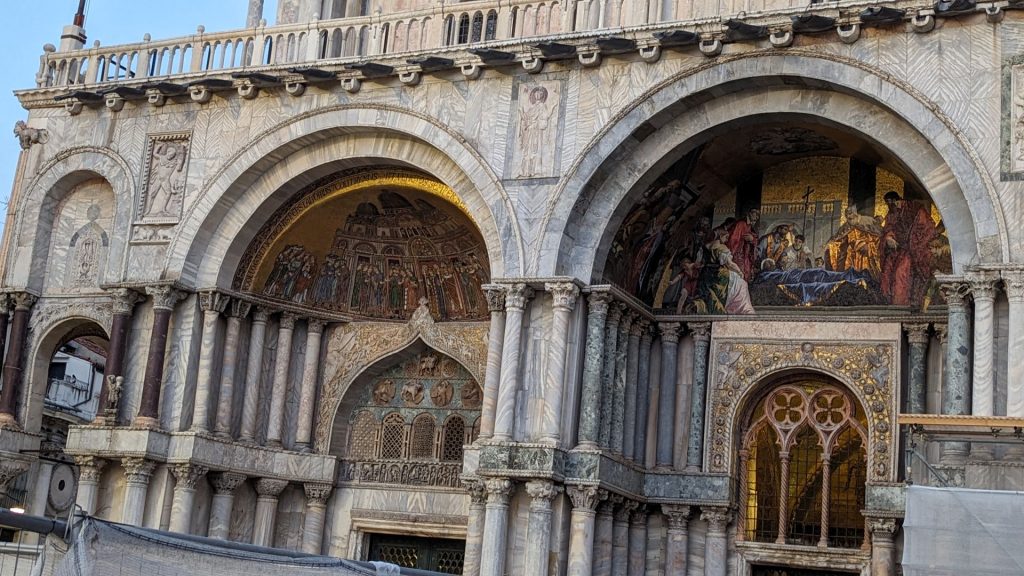
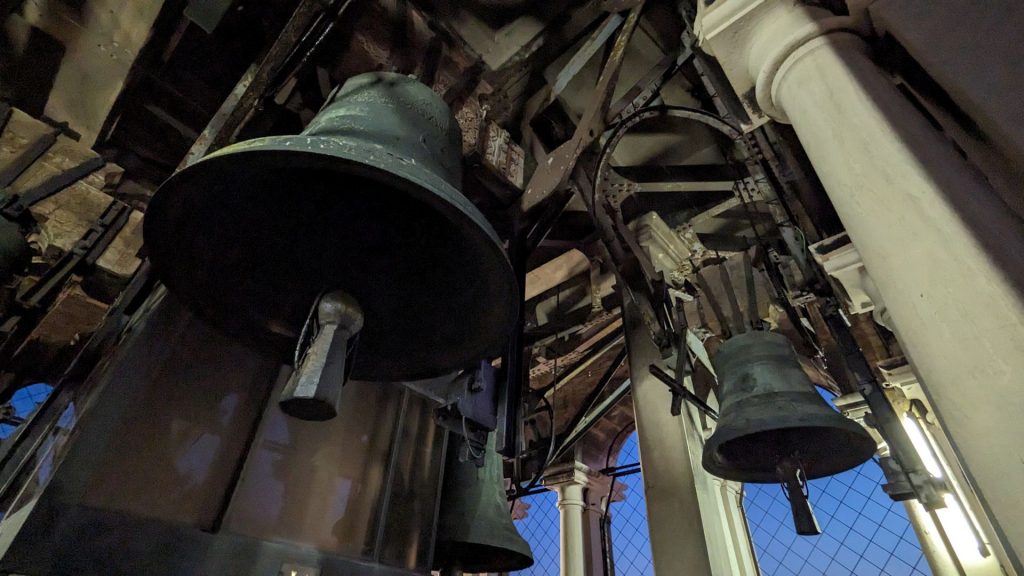
The pictures below are all taken from the Campanile. You can see that it gets darker as time goes on.
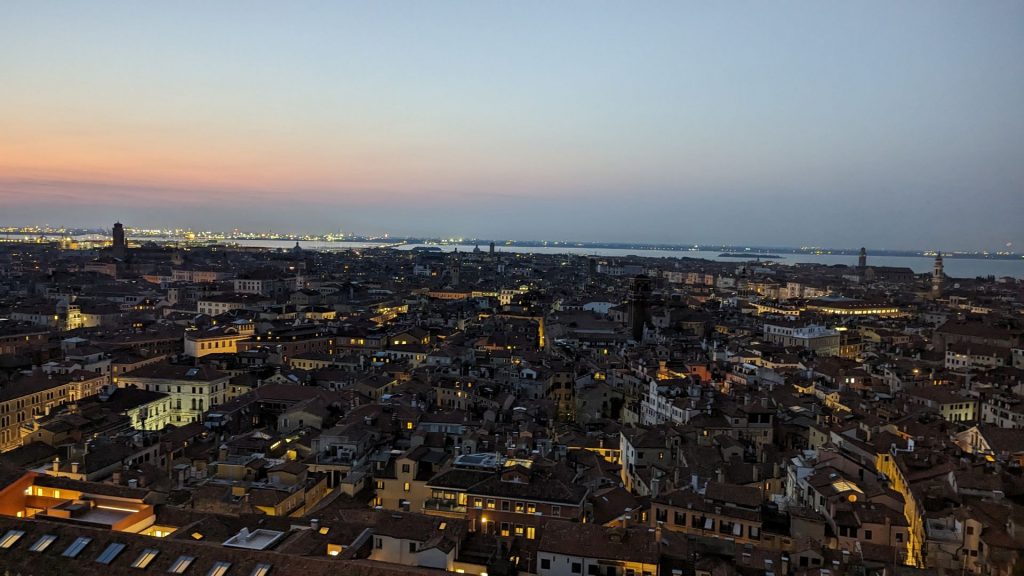
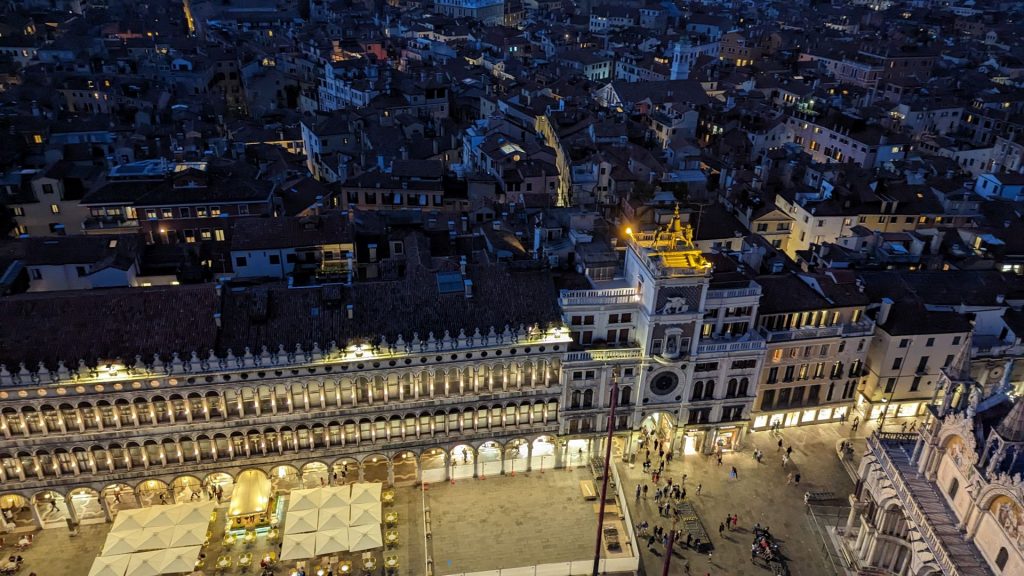
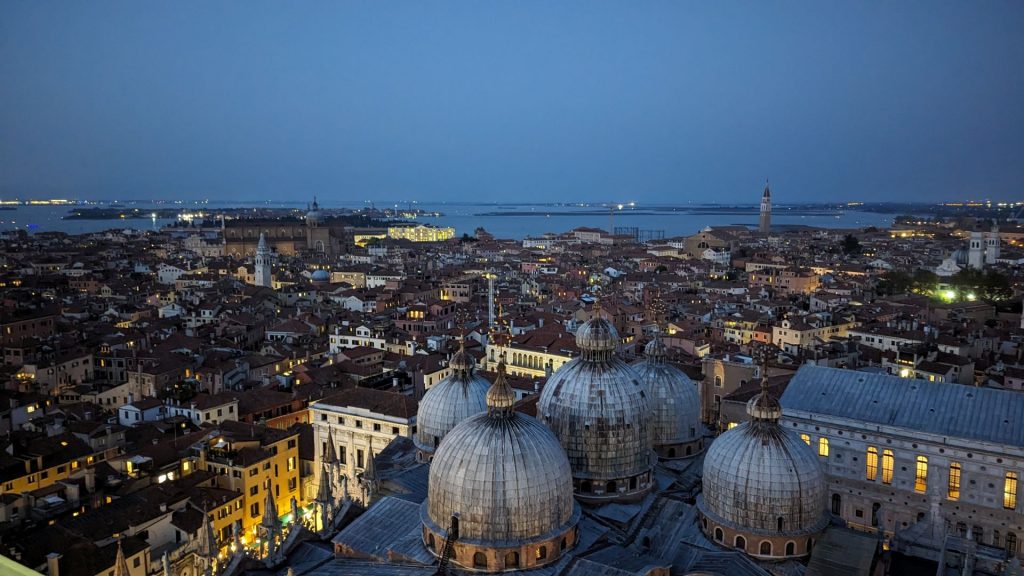
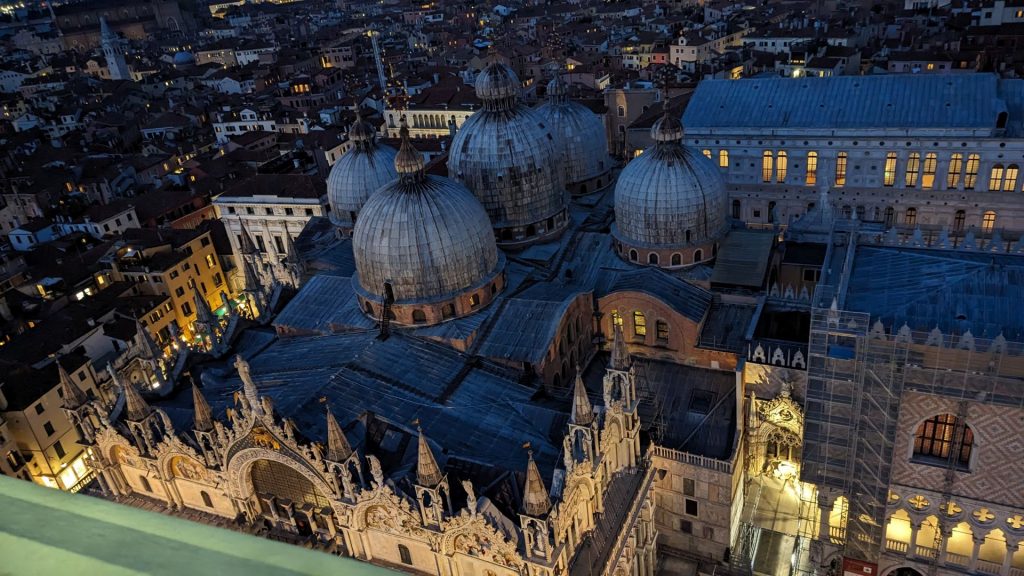
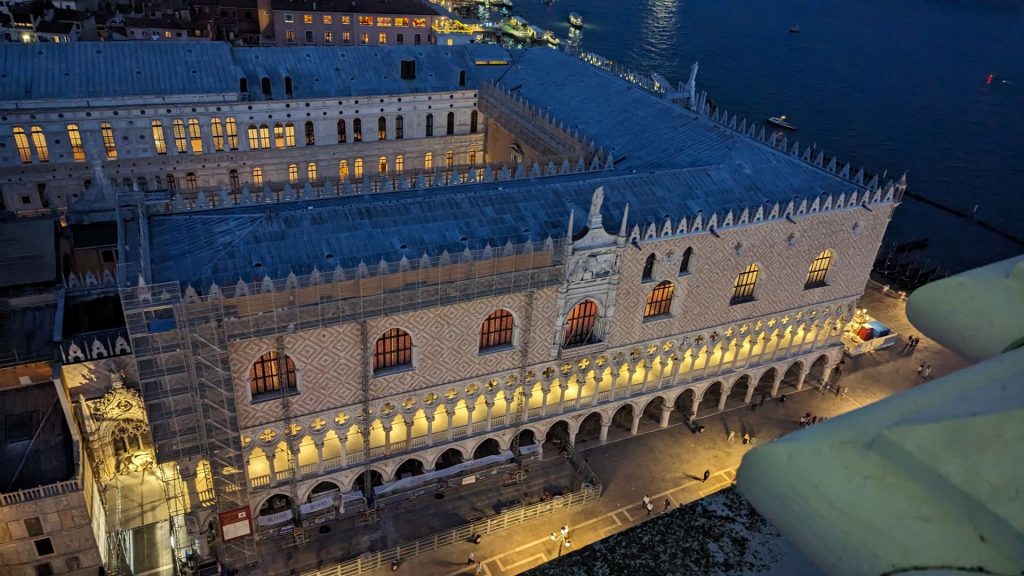
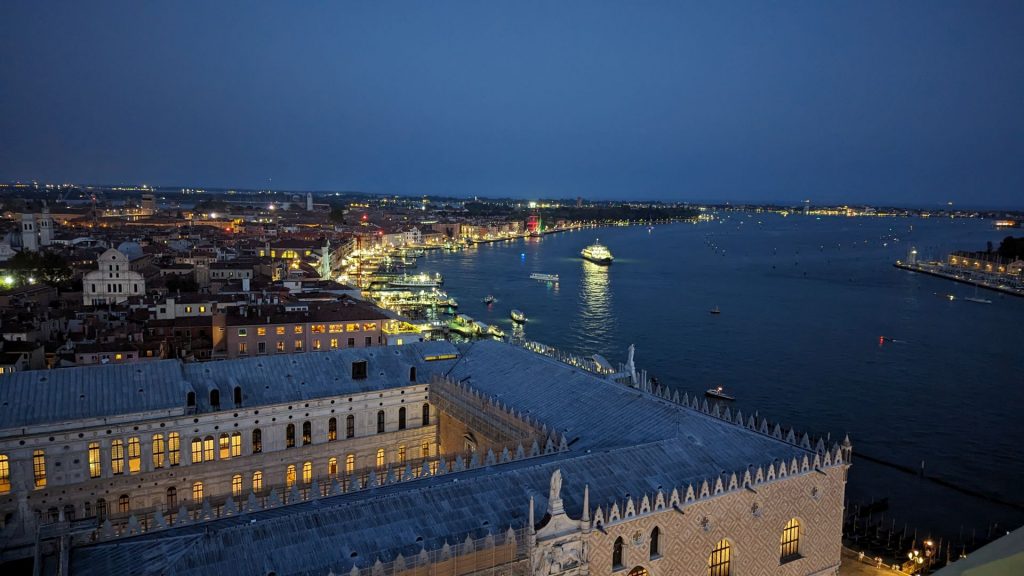
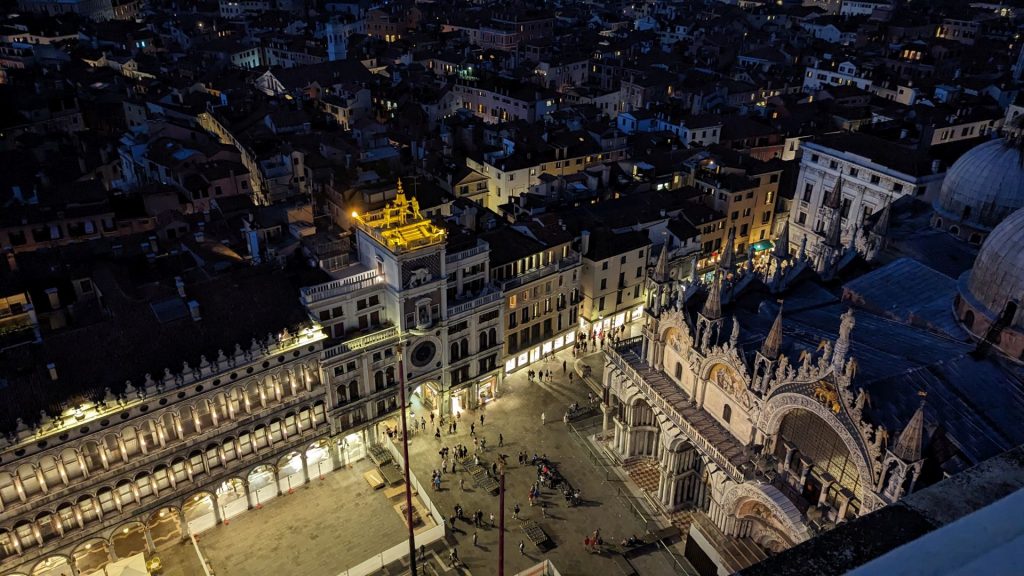
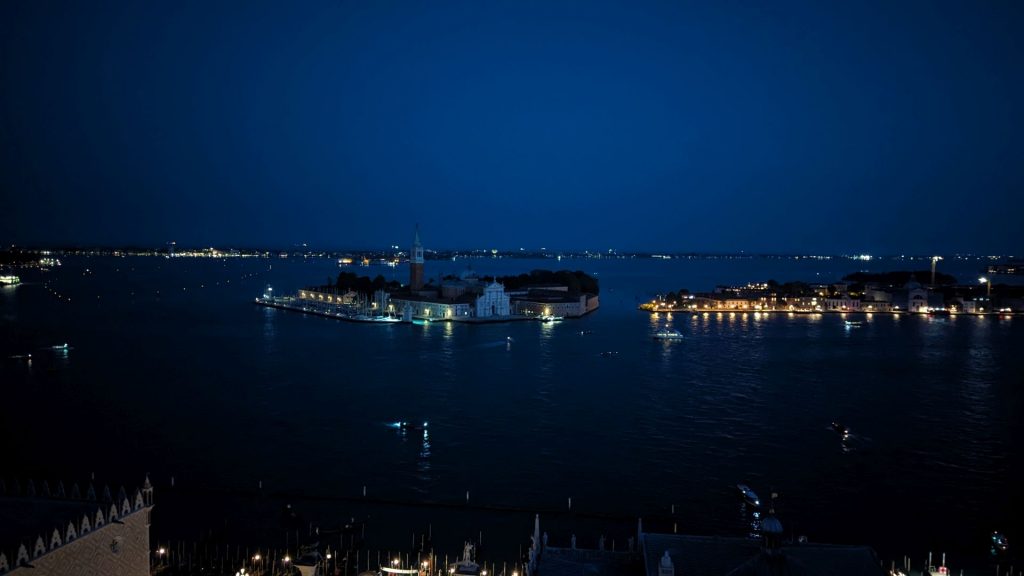
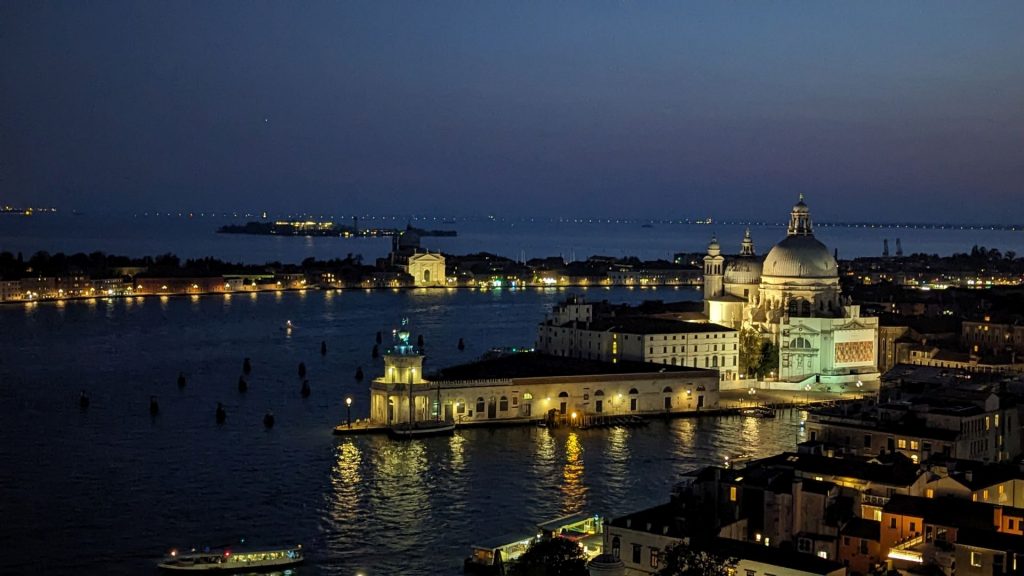
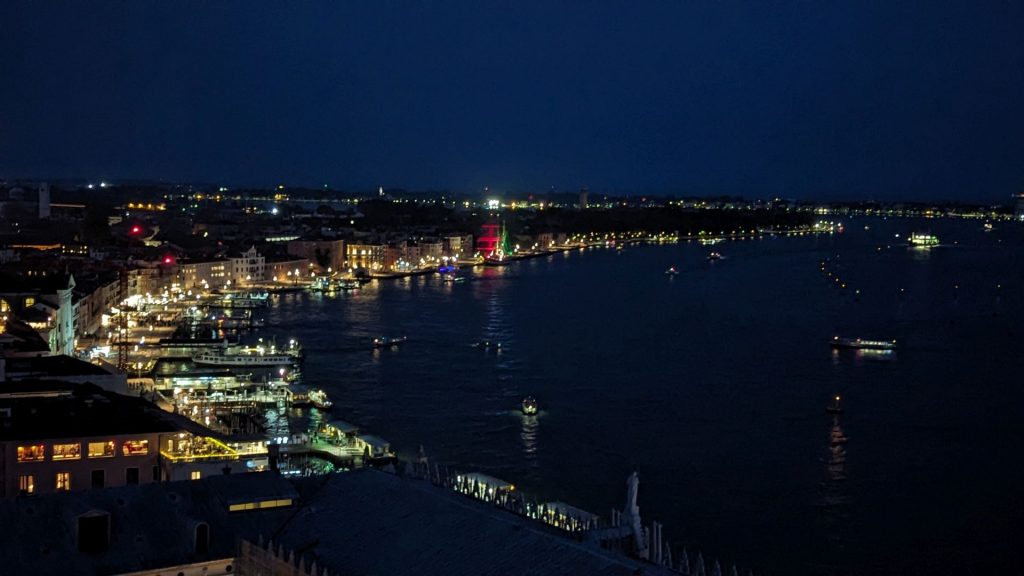
I’d read that they sometimes play music in St. Mark’s Square in the evening. I was uber excited to hear music playing when we came down from the Campanile. Michael and I decided to risk our bank balance and stop for a glass of wine/bowl of ice cream and listen to the music. Boy, am I glad we did!!! It was perfect and magical! (Oh, and it was uber expensive.) Here are some pictures of the sites, the musicians, and the expensive treats. 🙂
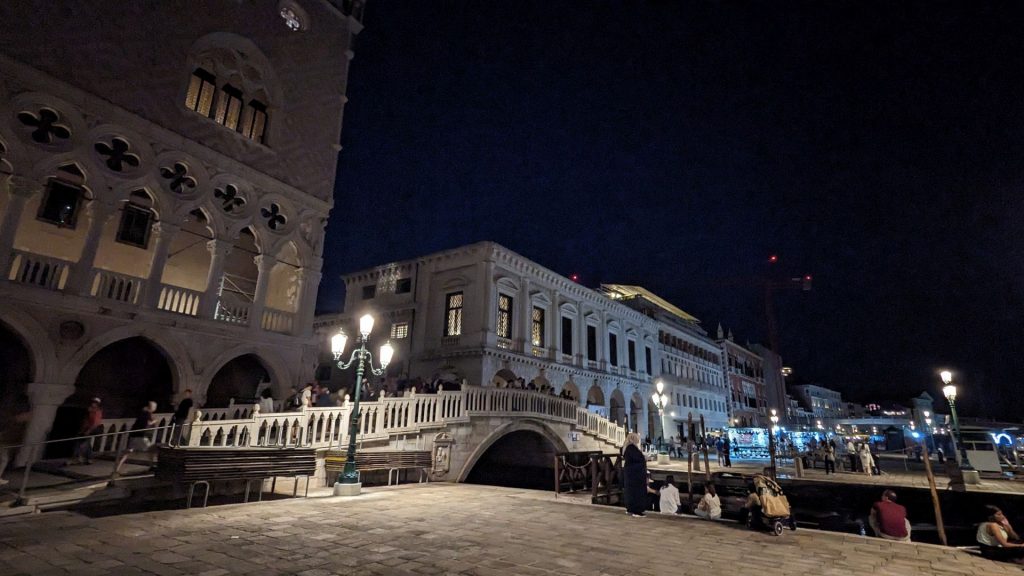
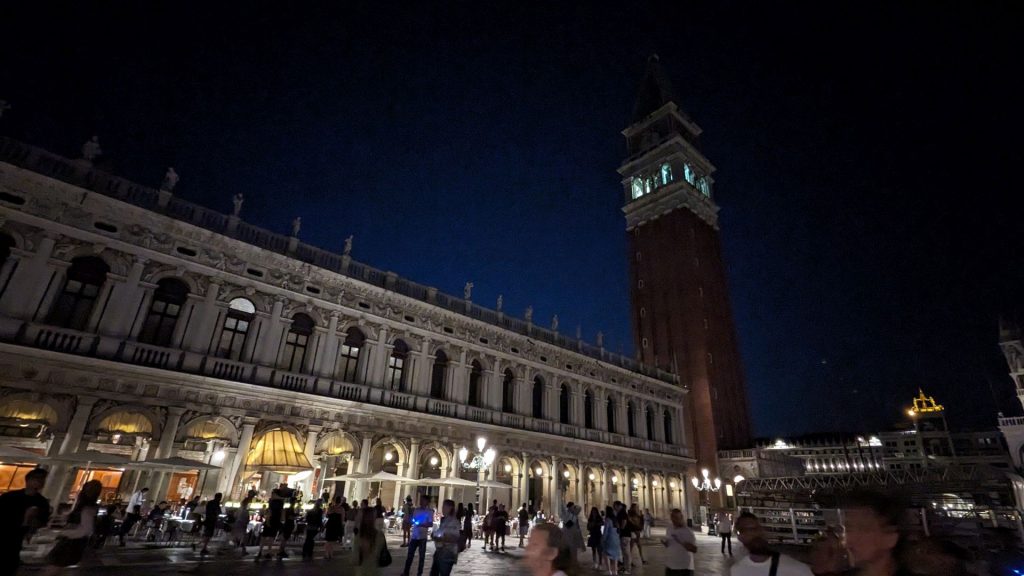
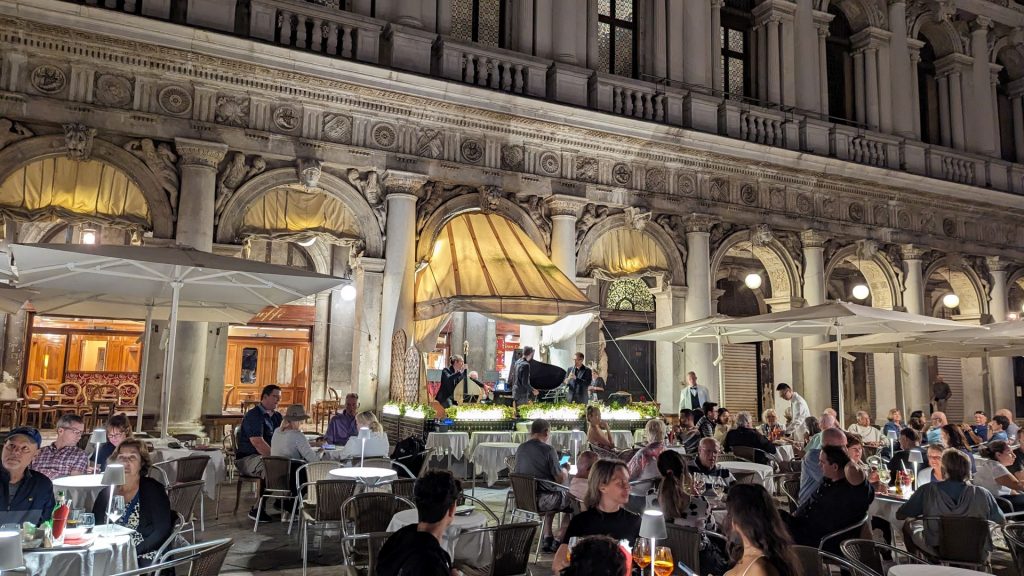
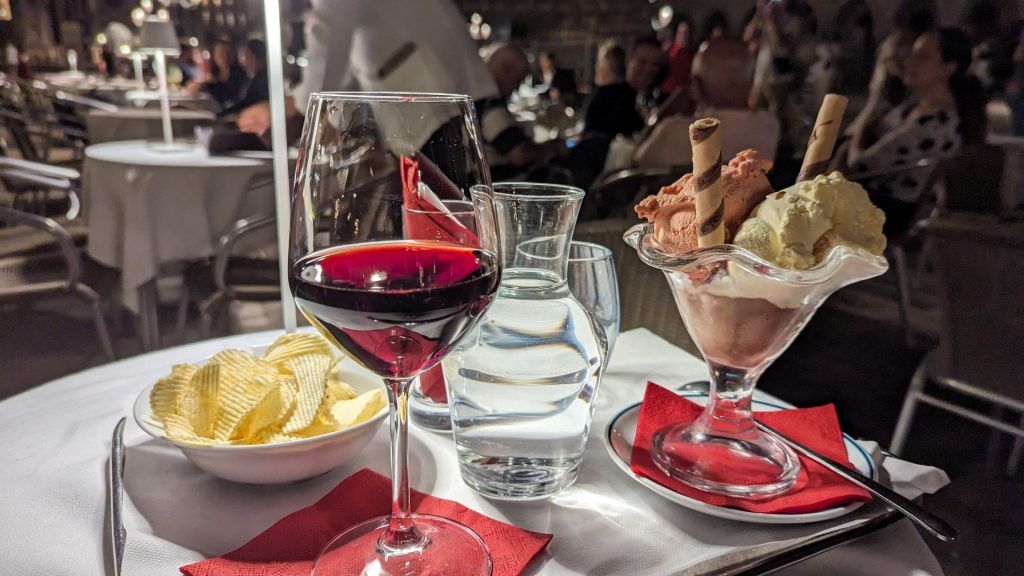
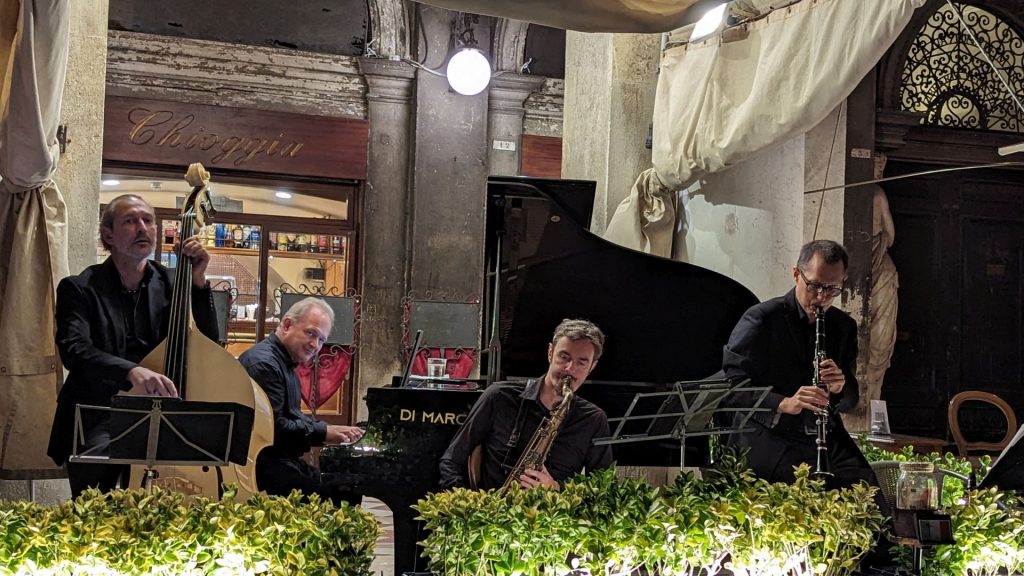
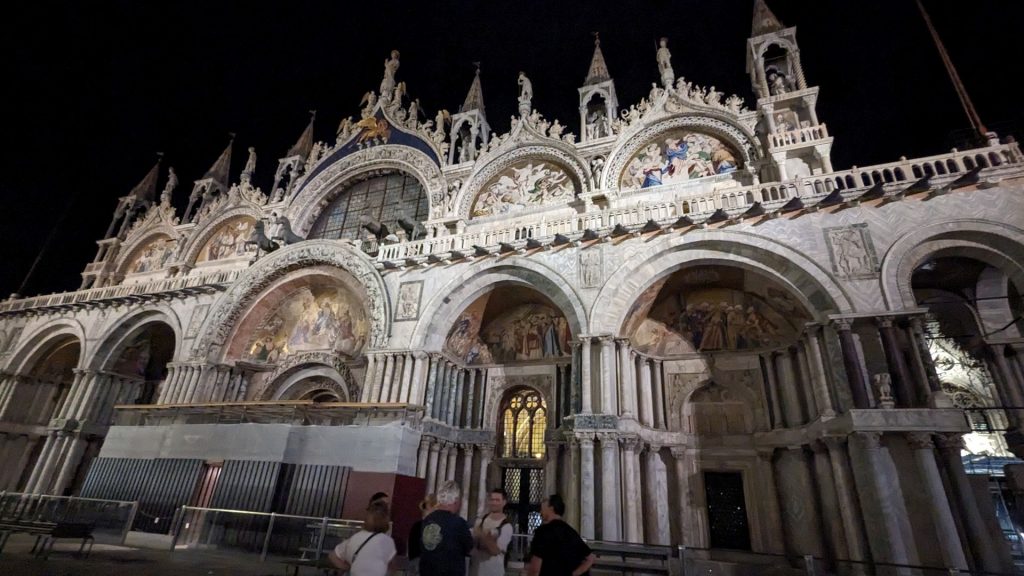
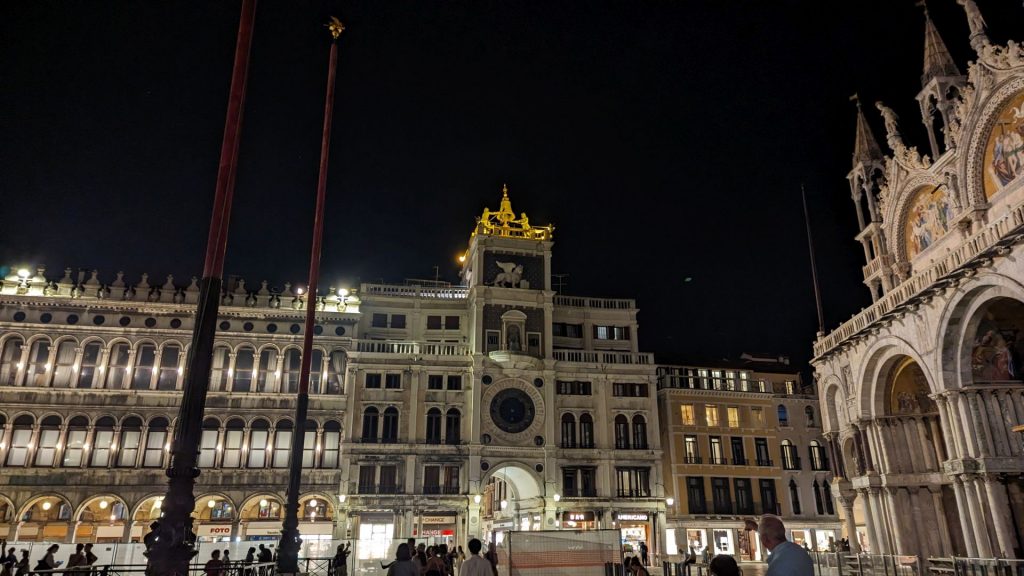
That was our first day/night in Venice. We only had one more full day before heading to Cinque Terre. We were ready for bed. We followed Google maps back to our hotel room (thank goodness for Google maps!), used the three keys to get to our room, and passed out.
Day Two:
We might want to title day two, “A Pictorial Ode to Basilica Santa Maria Gloriosa dei Frari.” I was so taken by this basilica, from the artwork, to the monuments, to the sculptures. . . it was overwhelmingly beautiful and ornate. I am guessing that not all of you have the same appreciation for this type of thing, and that is totally and completely fine and understandable. For those who do appreciate it, I hope you enjoy the photos (which are not all of great quality, but you get what you can get given the quality of the phone camera, lighting, access, etc.).
But before we reached the Frari, we ate breakfast and walked around a bit. Here are some pictures of the squares, colors, food, canals, etc.
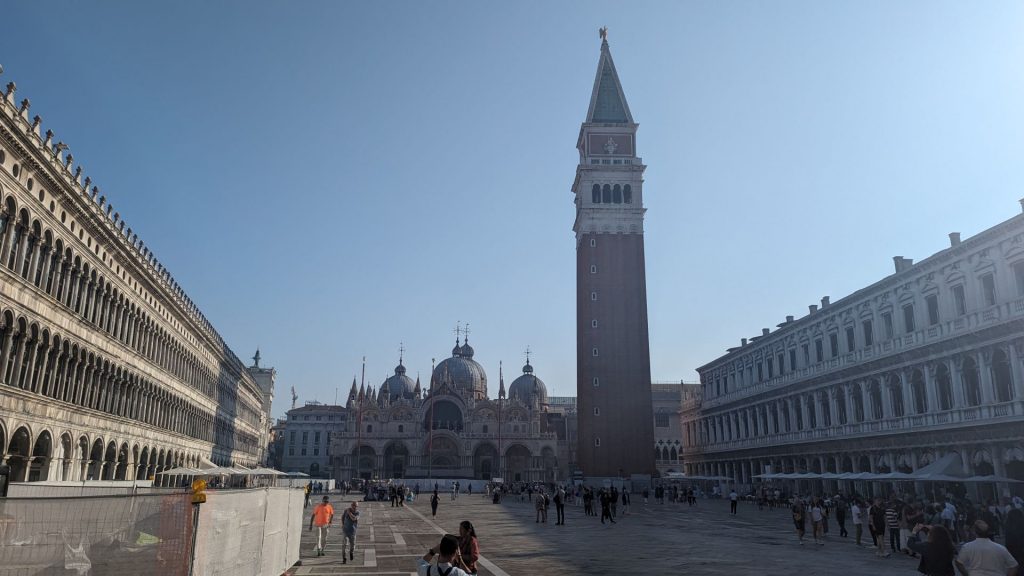
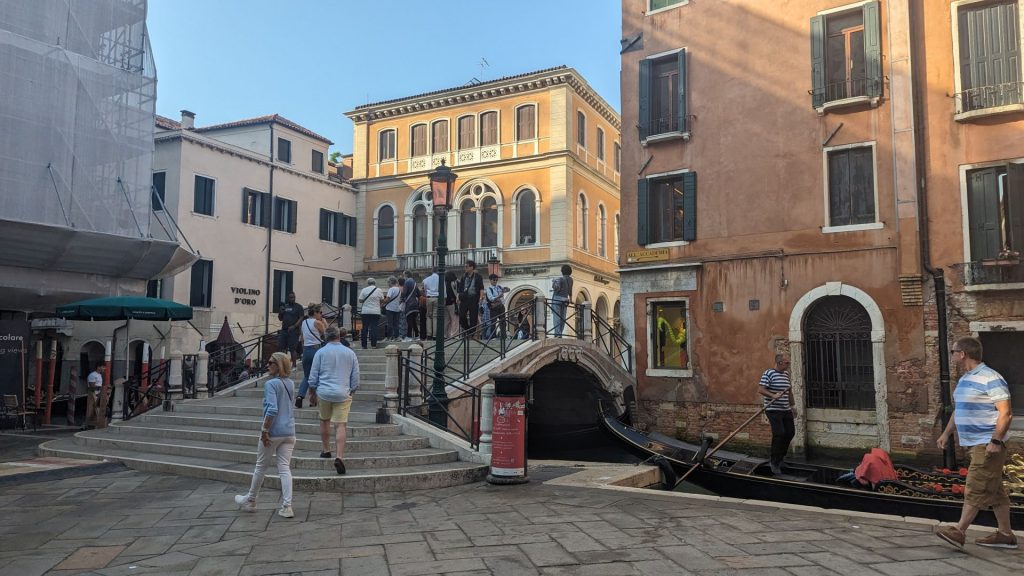
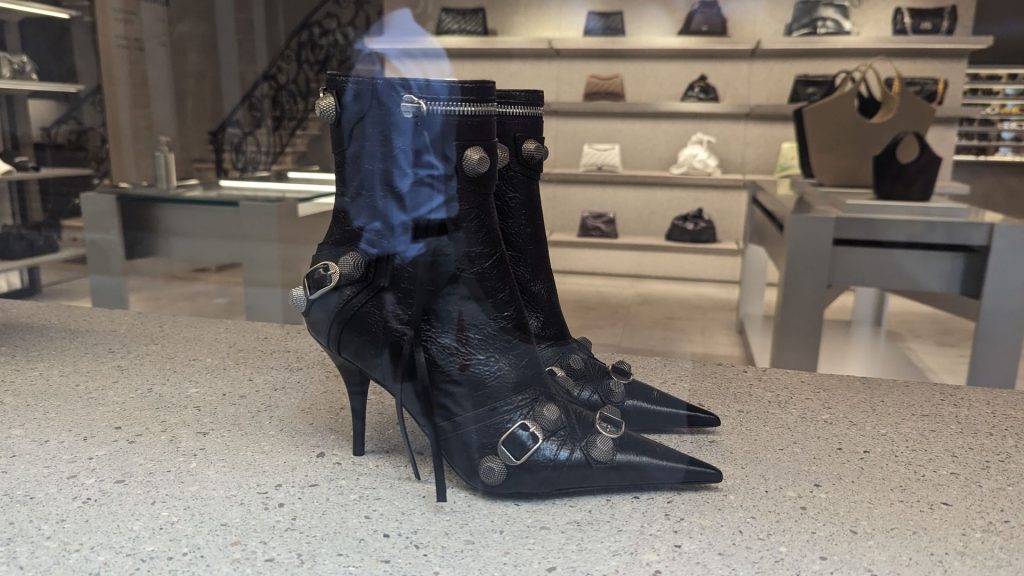
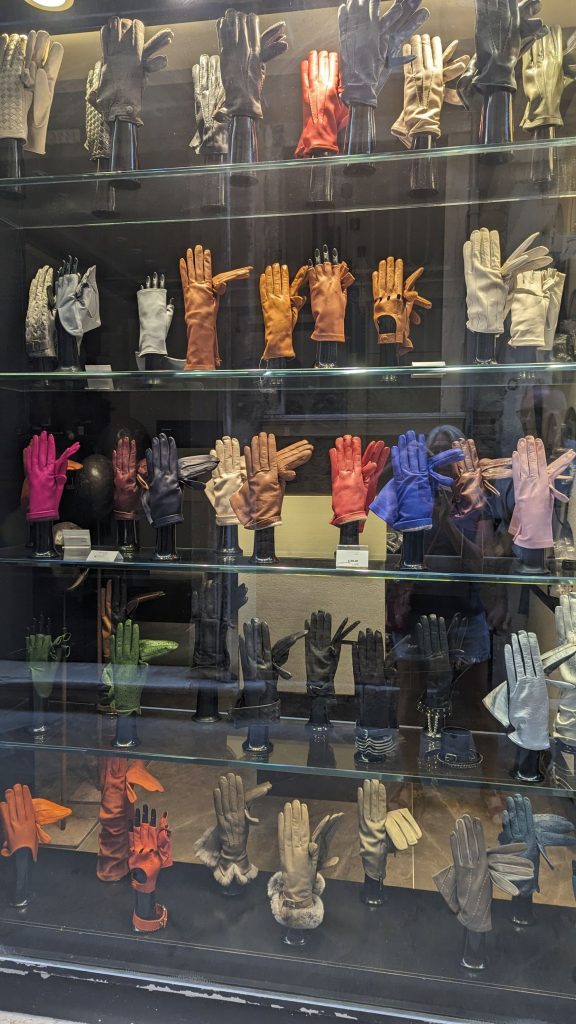
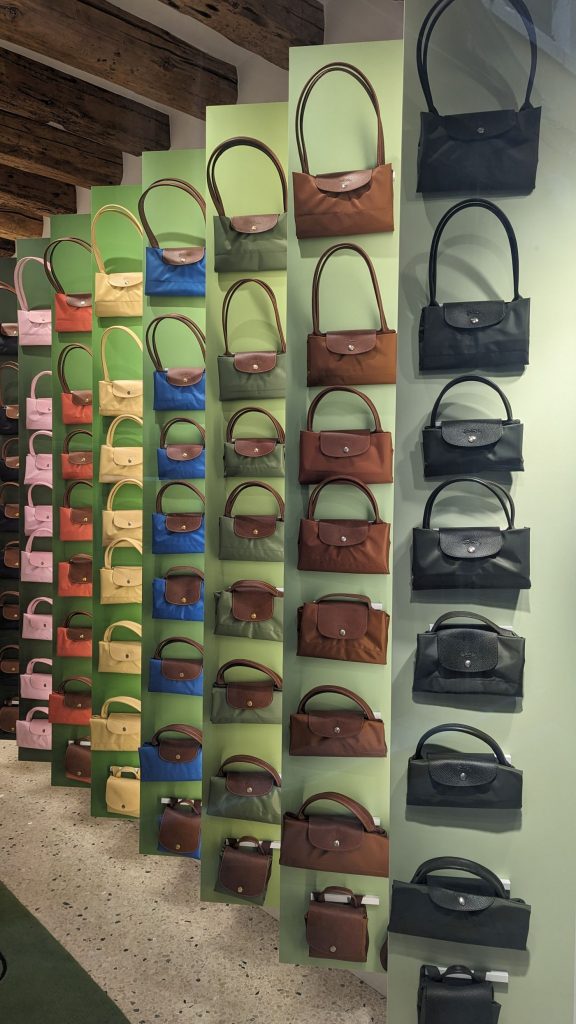
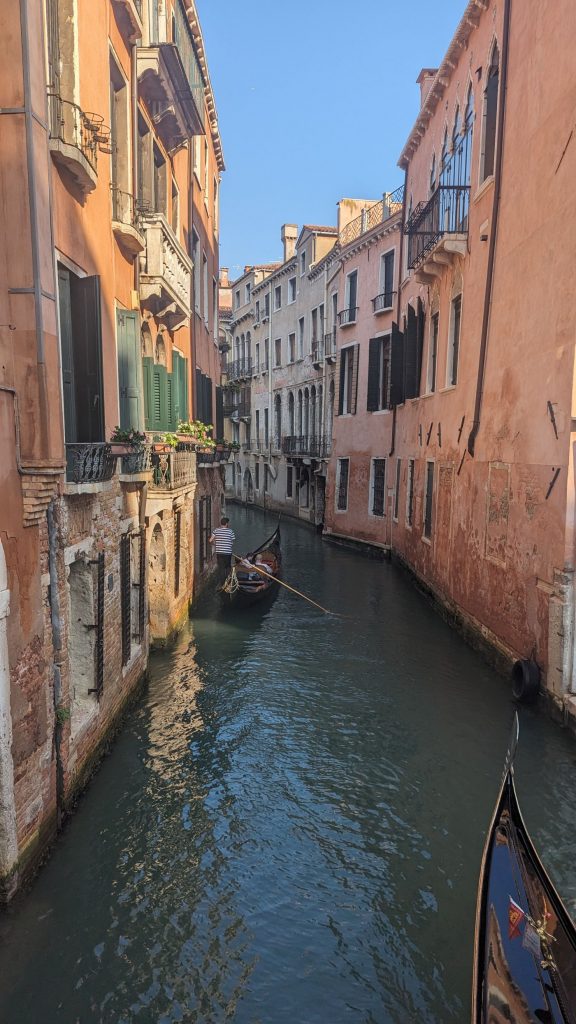
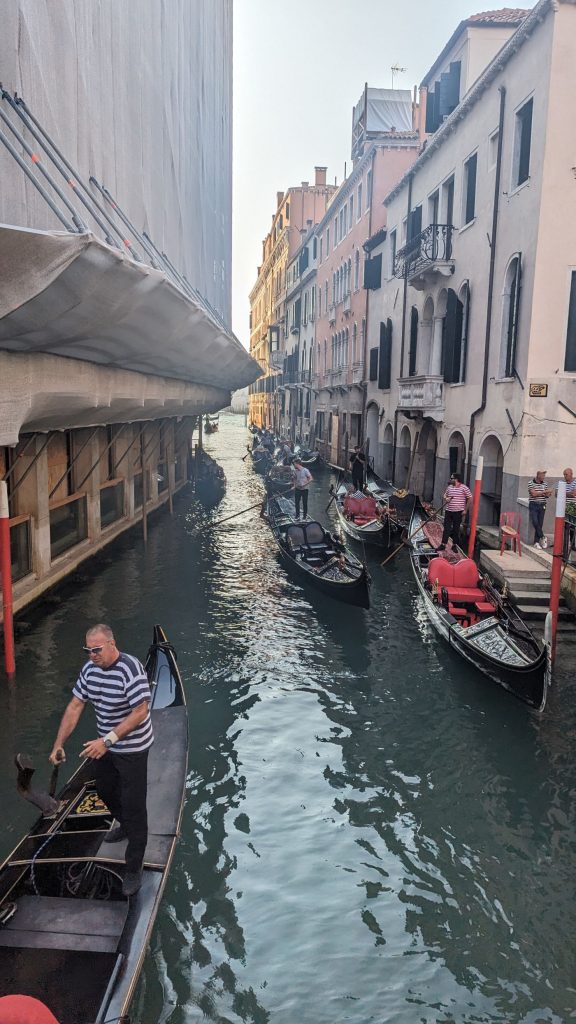
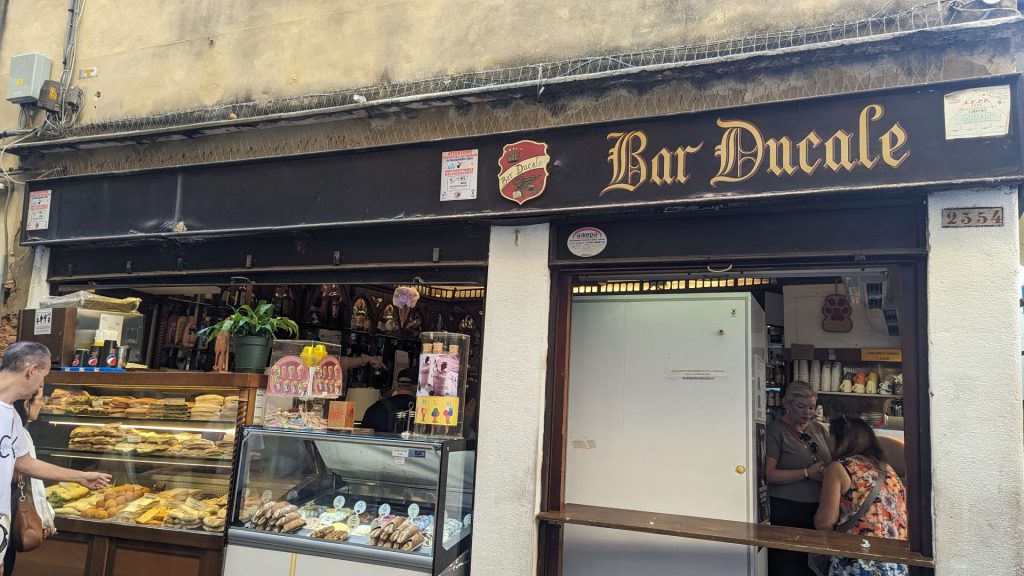
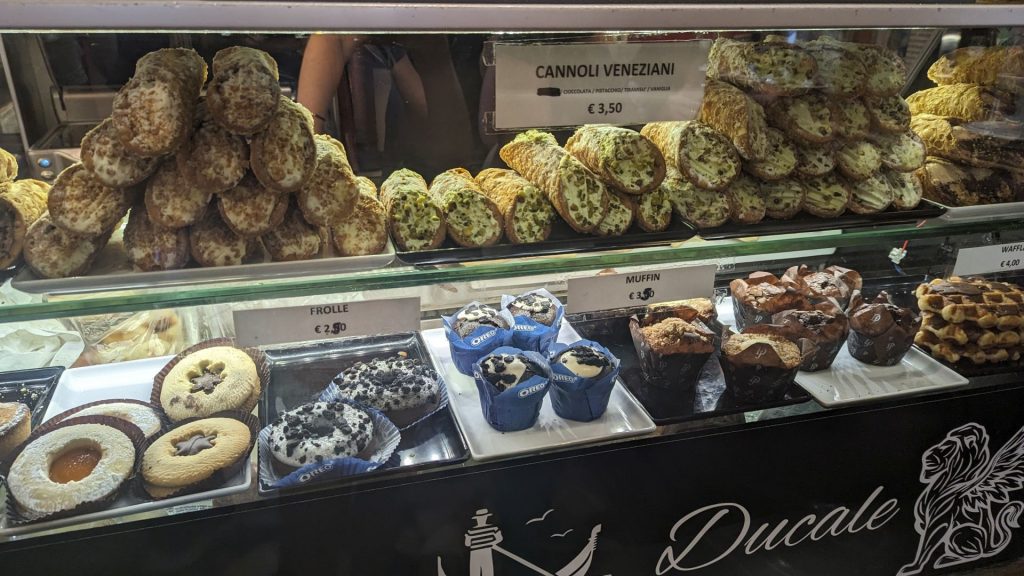
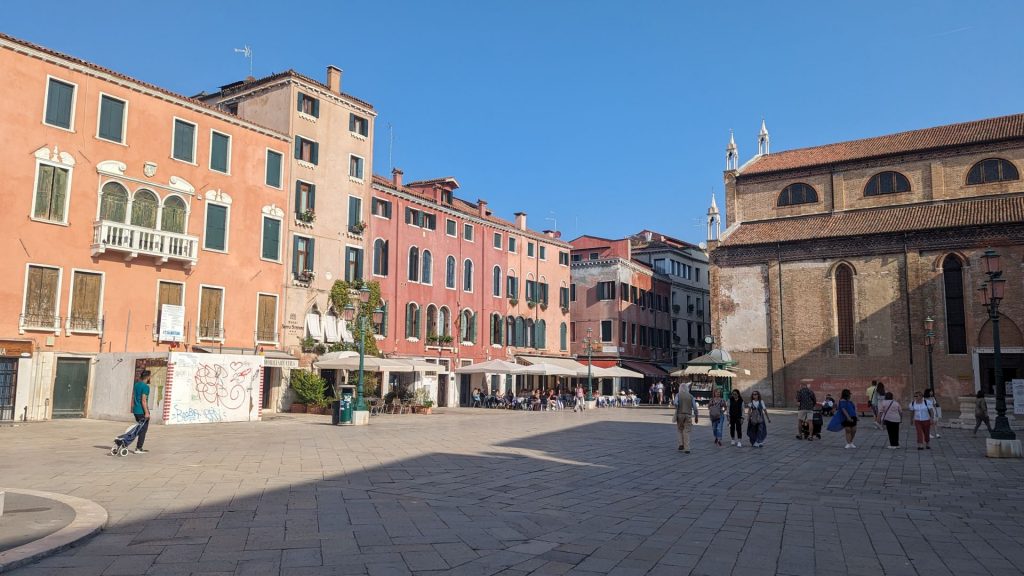
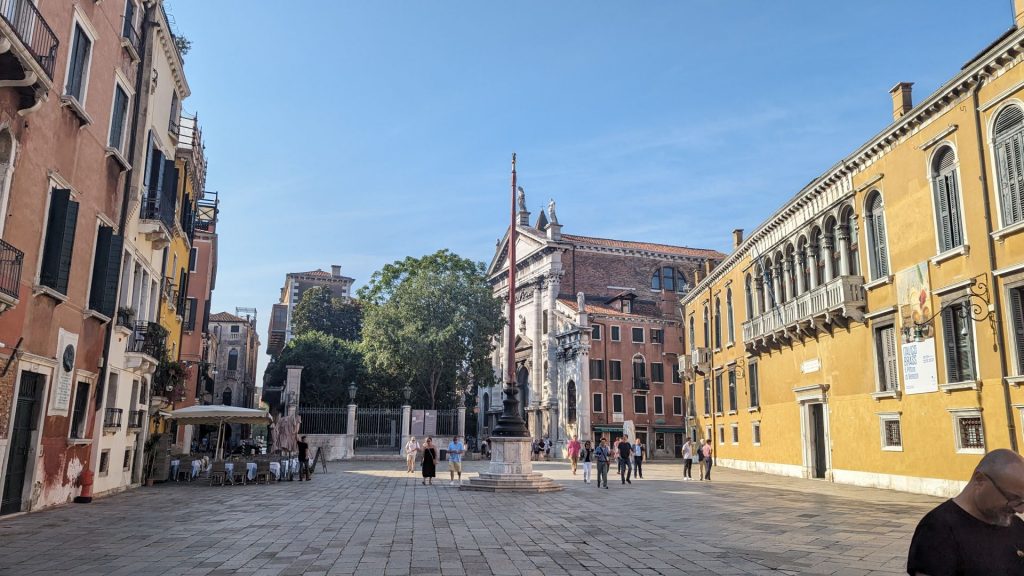
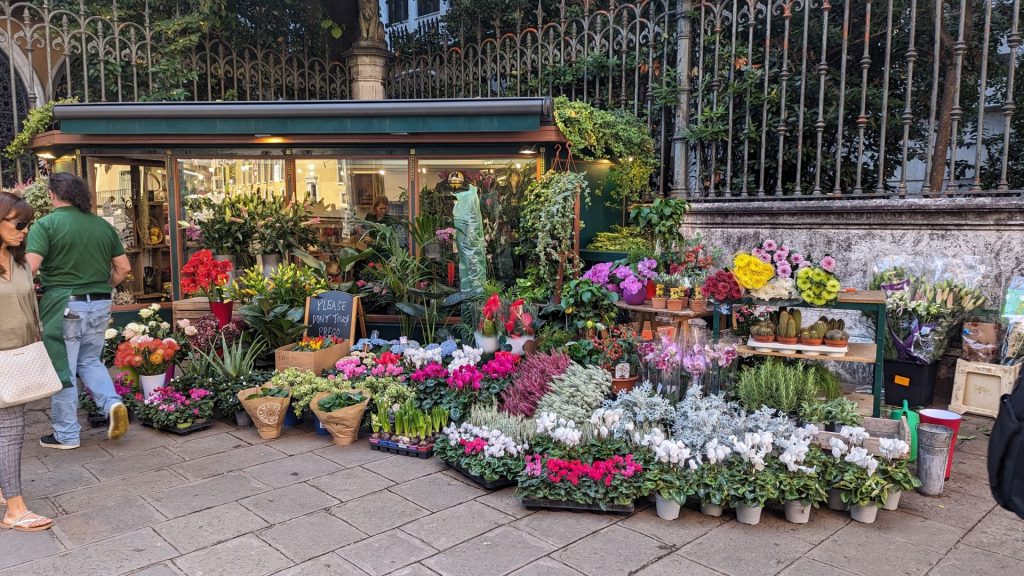
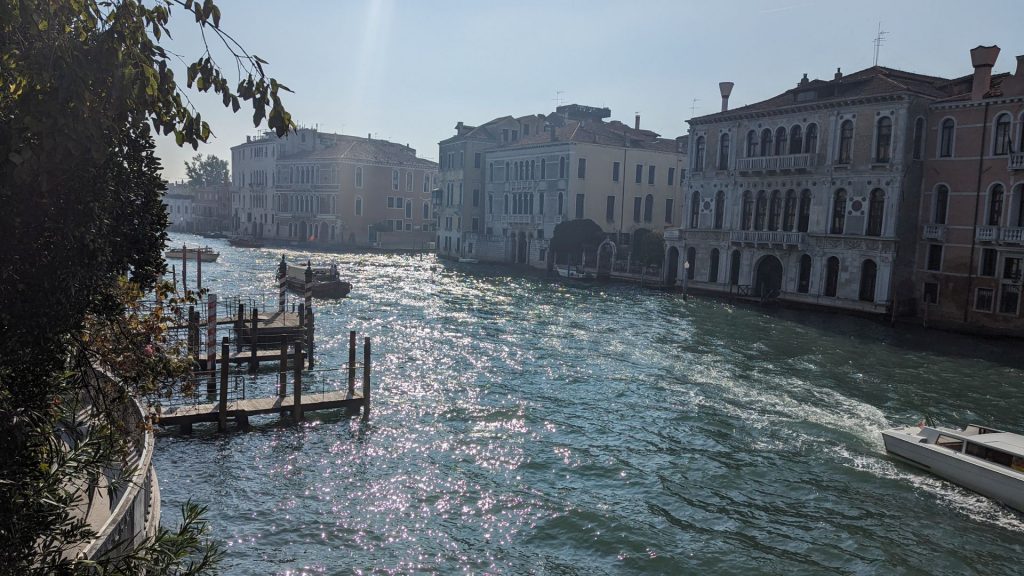
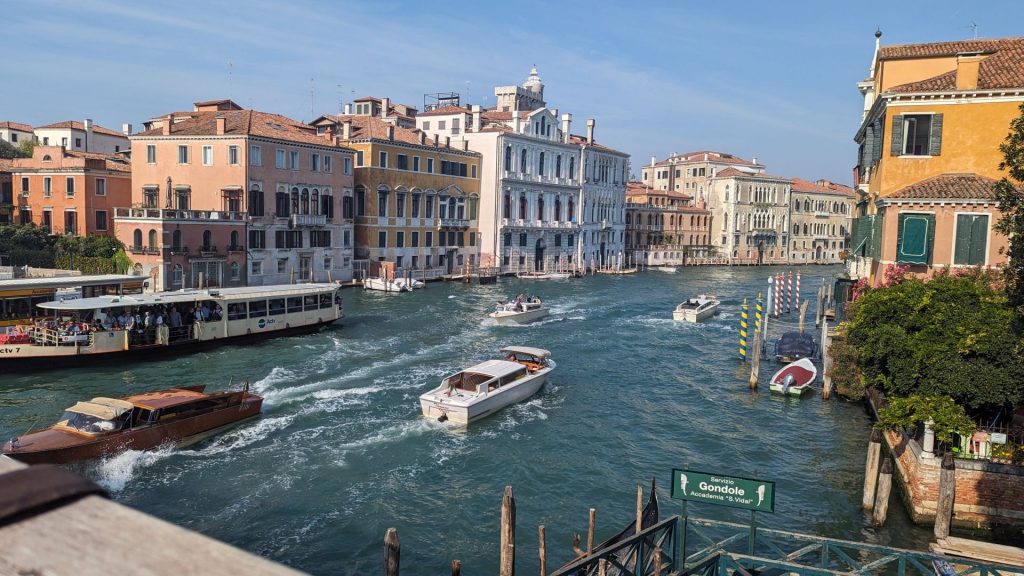
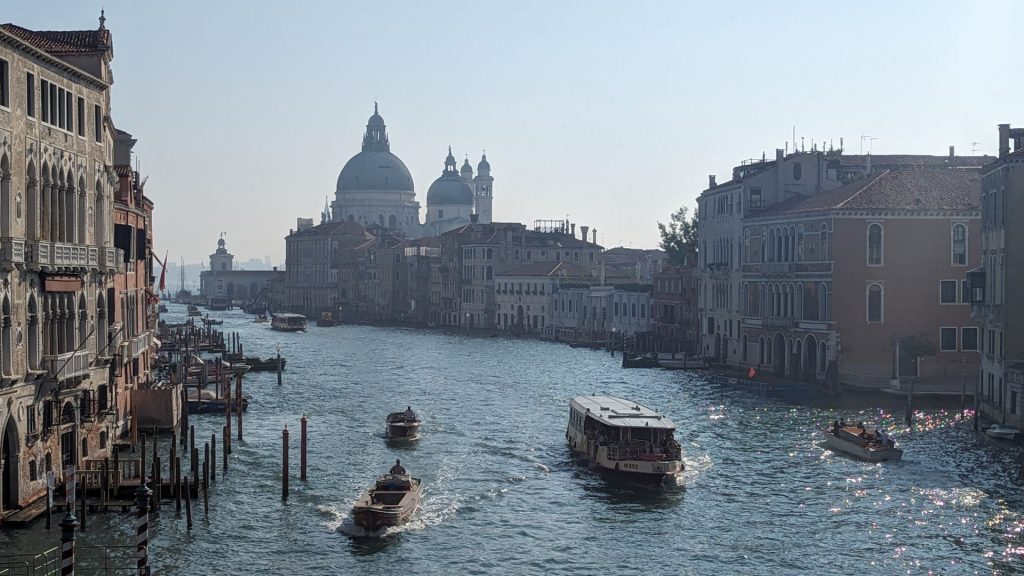
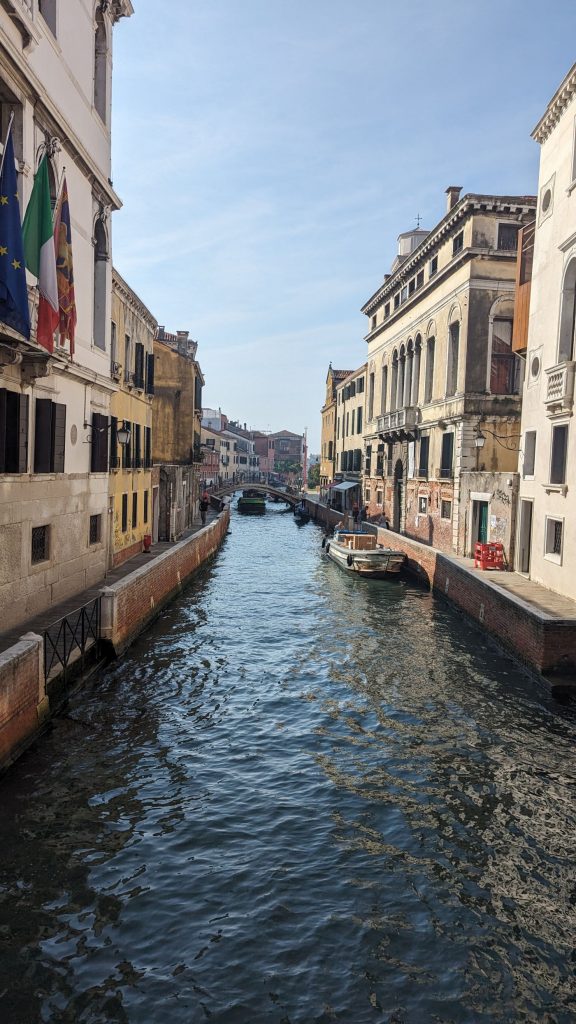
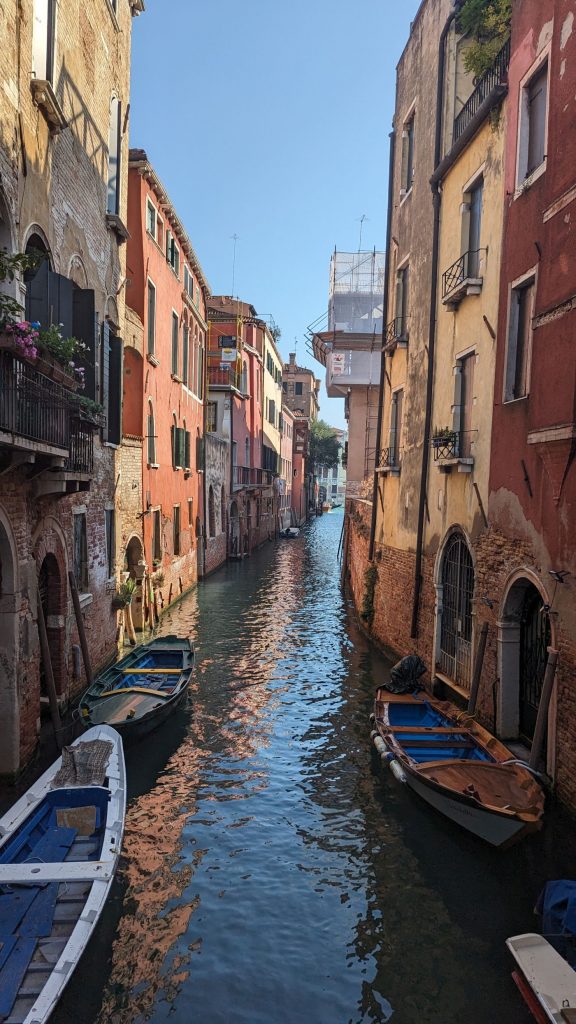
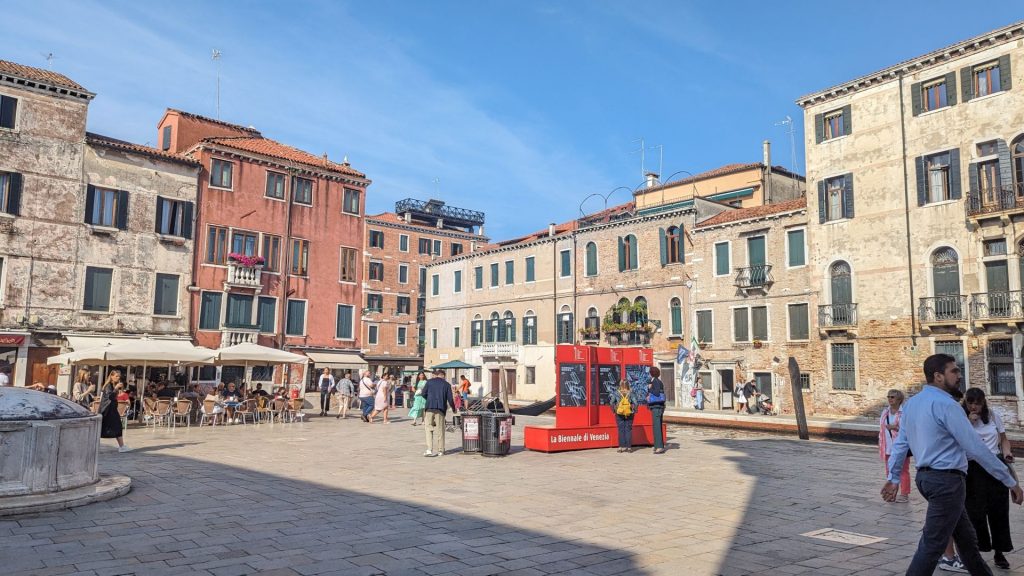
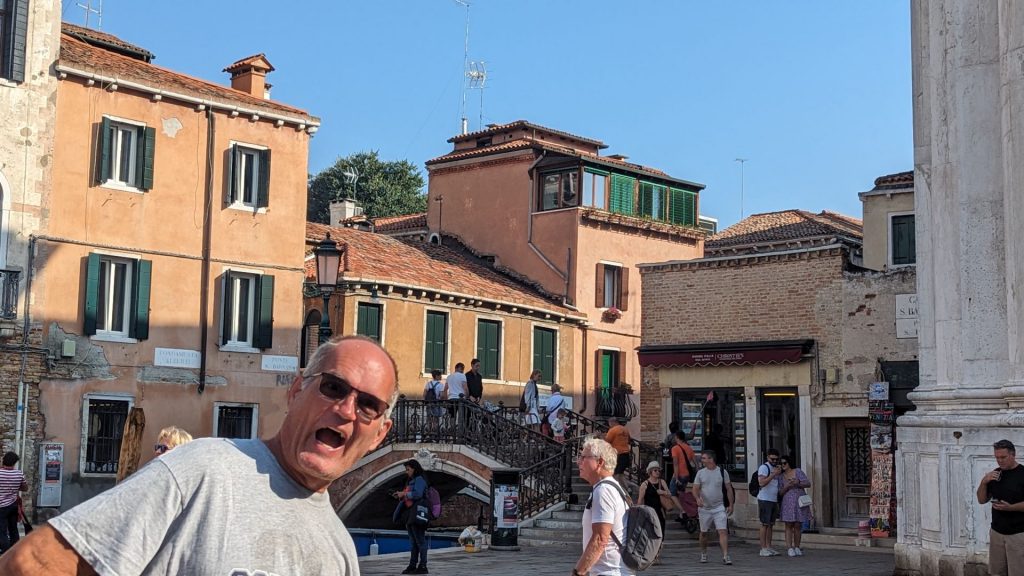
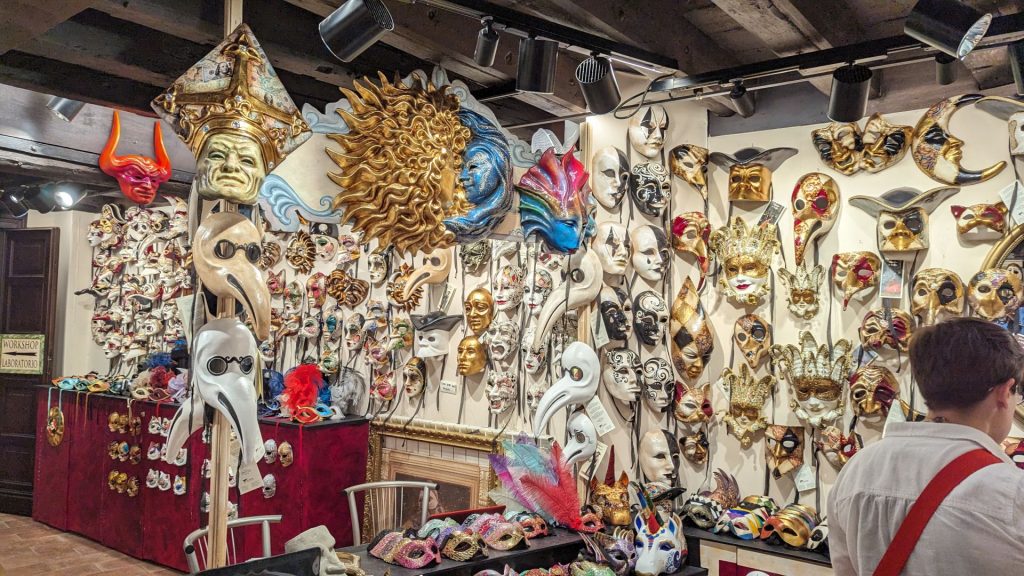
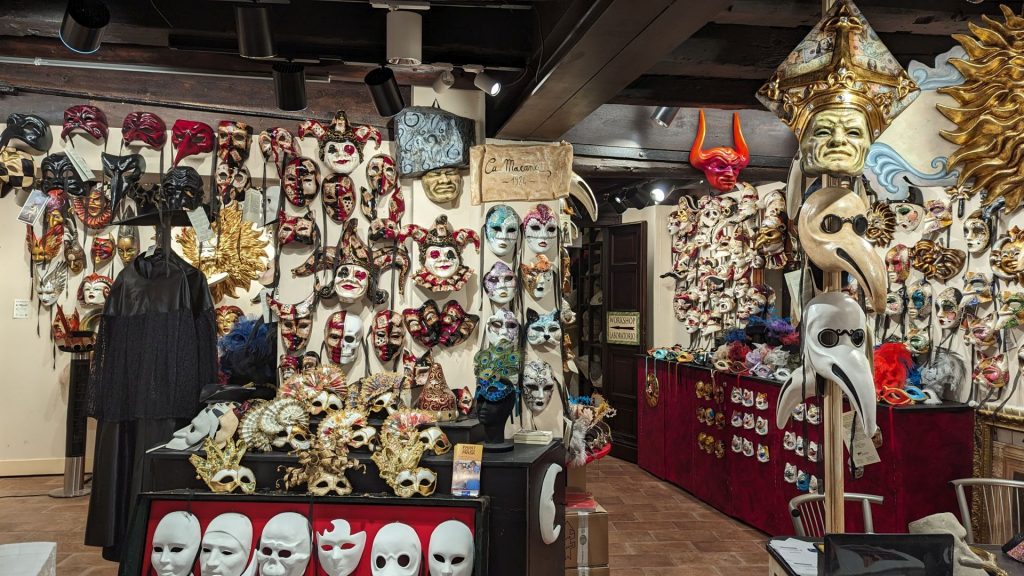
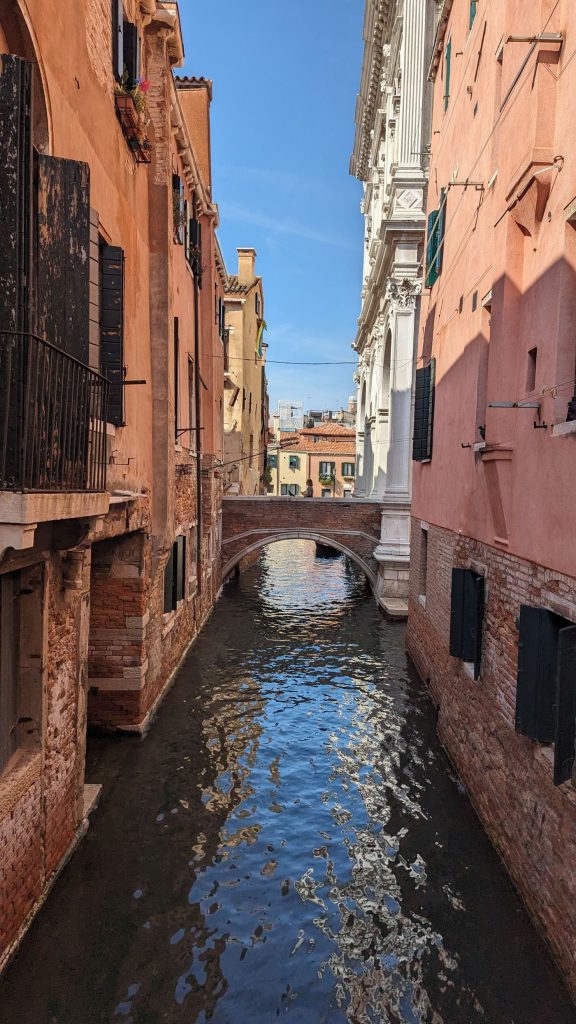
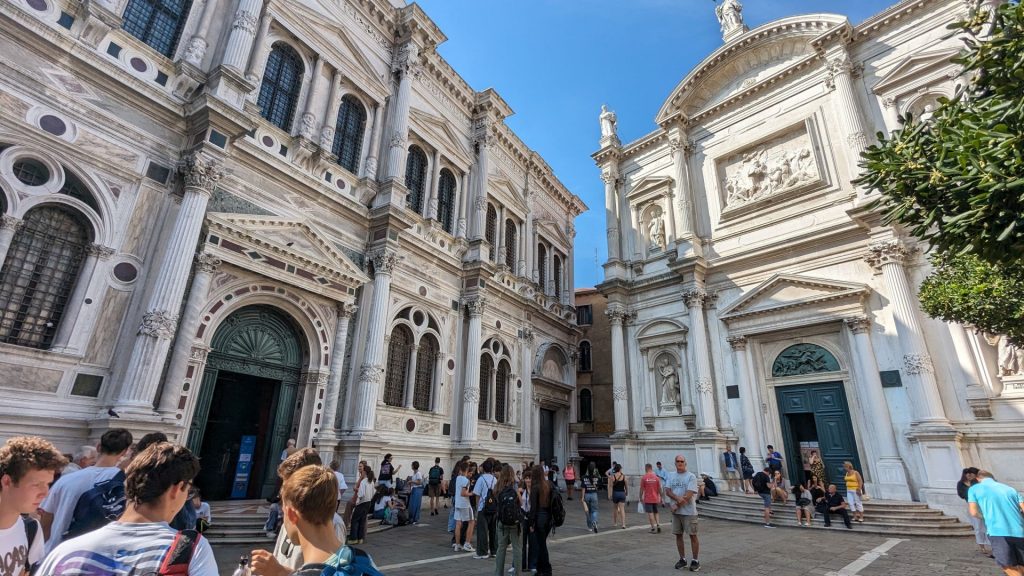
And now, the basilica! A bit of information about the basilica (from a combination of sources):
The Basilica di Santa Maria Gloriosa dei Frari, commonly abbreviated to the Frari, is a church located in the Campo dei Frari at the heart of the San Polo district of Venice. It is the largest church in the city and it has the status of a minor basilica. The church is dedicated to the Assumption of Mary.
The imposing edifice is built of brick and is one of the three notable churches in the city that retain most of their Venetian Gothic appearance. In common with many Franciscan churches, the exterior is rather plain, even on the front facade. The exterior features a bell tower.
Interior
The twelve huge round pillars between the nave and the aisles represent the apostles, but the division of the nave and aisles is pretty unobtrusive, giving the impression of a single space dissected up high by tie-beams. The tie-beams are there for stability in a sinking city. Dominating the center of the church is the dark wood of the monumental monks’ choir (a rare survival in Venice) erected in 1468. The 124 choir stalls feature fine carving and intarsia by Marco Cozzi, depicting views of an ‘ideal city.’ This choir for the friars is separated from the nave of the lay congregation by a carved marble screen of 1475, an early work from the workshop of Pietro Lombardo. This screen is strictly to be called a pulpitum, as it has a marble pulpit at each end, and is the best preserved example of such tramezzi, most of which were destroyed in Italy in the late 16th century.
The interior is notable for many tombs and works of art that accumulated in the centuries after it was built. It contains many very grand wall monuments to distinguished Venetians buried in the church, including a number of Doges. Many of these are important works in the history of Venetian sculpture, including that by Donao. Paintings in situ include two large and important altarpieces by Titian, the Assumption of the Virgin on the high altar and the Pesaro Madonna in a chapel.
History
In 1231, under Doge Jacopo Tiepolo, the city donated land at this site to establish a monastery and church belonging to the Franciscan Order of Friars Minor. This edifice proved too small and a three-nave church was begun in 1250, but not completed until 1338. Work almost immediately began on its much larger replacement, the current church, which took more than a century to build. The new church inverted the original orientation, thus placing the facade so that it faces the plaza and small canal. The work was started under Jacopo Celega, but completed by his son Pier Paolo. The campanile, the second tallest in the city after that of San Marco, was completed in 1396. Under the patronage of Giovanni Corner, the Chapel of San Marco was added in 1420. In 1432-1434, Bishop Vicenza Pietro Miani built the chapel of San Pietro next to the bell-tower. The facade was not completed until 1440. The main altar was consecrated in 1469. In 1478, the Pesaro family commissioned a chapel in the apse of the church. On 27 May 1492, the church was consecrated with the name of Santa Maria Gloriosa.
Architectural Features
The church overall is in the Venetian style, as the walls were made of red brick, the beams were decorated on the inside, and details were made of Istrian stone. In common with many Franciscan churches, the exterior is rather plain, even on the front facade.
It also has Roman influence, because the columns in the nave contain large cylindrical shafts. The church also contains six smaller chapels as well as the main chapel, three on each side of the main chapel. The baptistery and sacristy were featured along with two other chapels, making the church a family chapel.
The church overall has a vaulted Gothic rib ceiling, making the interior volume large. The church does not have a central dome, making it unique.
I am now going to inundate this post with pictures!
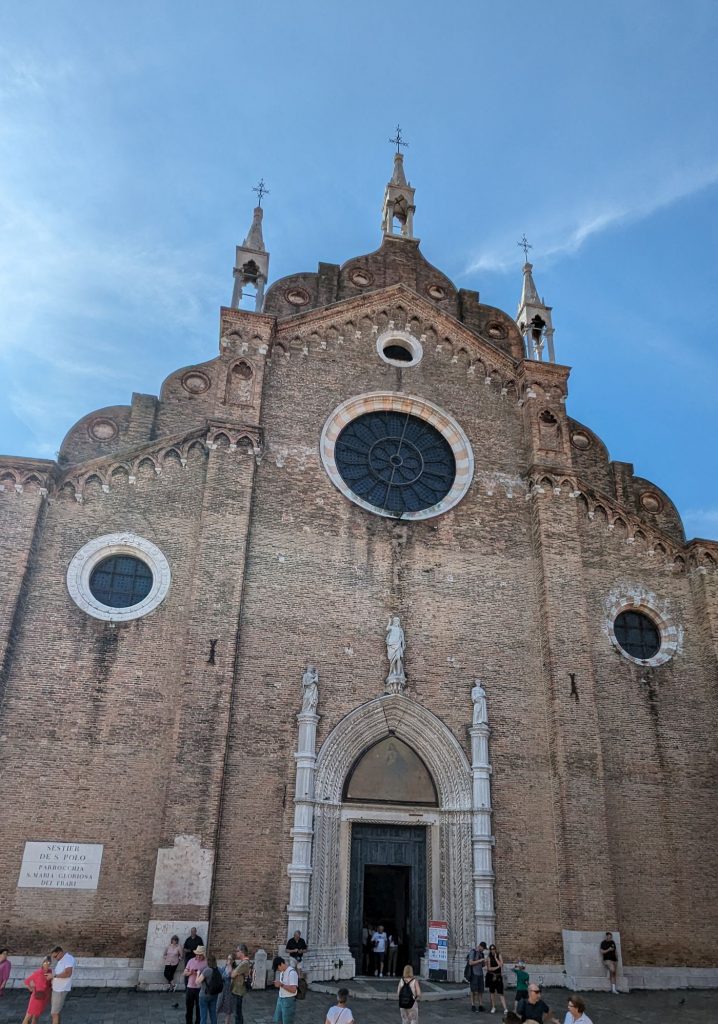
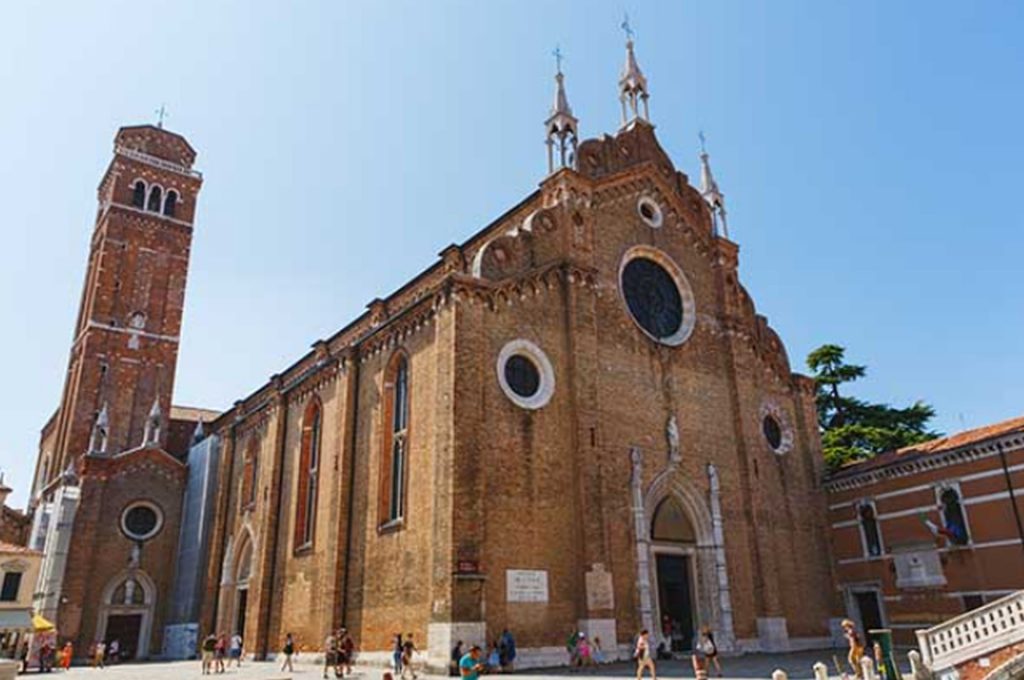
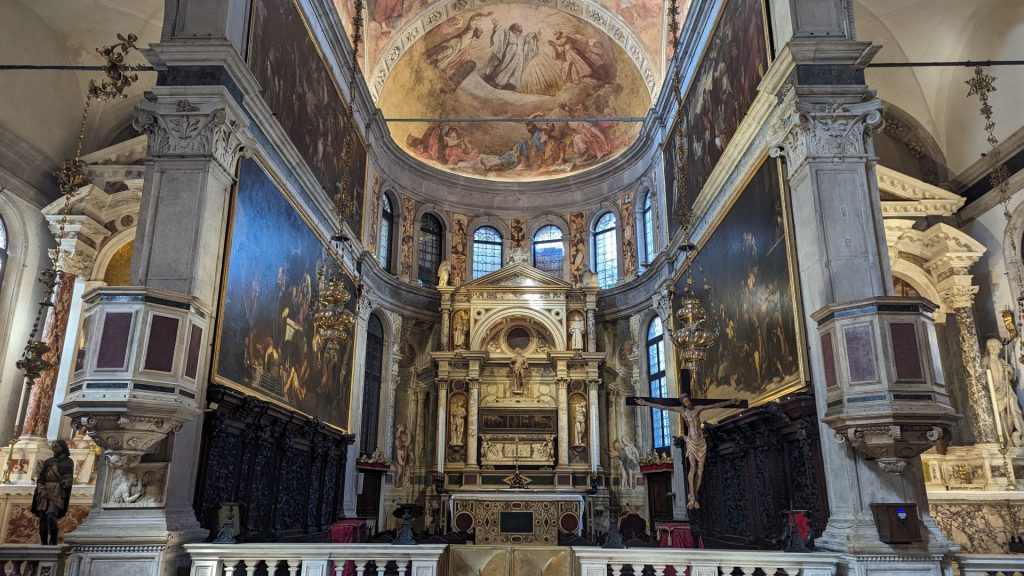
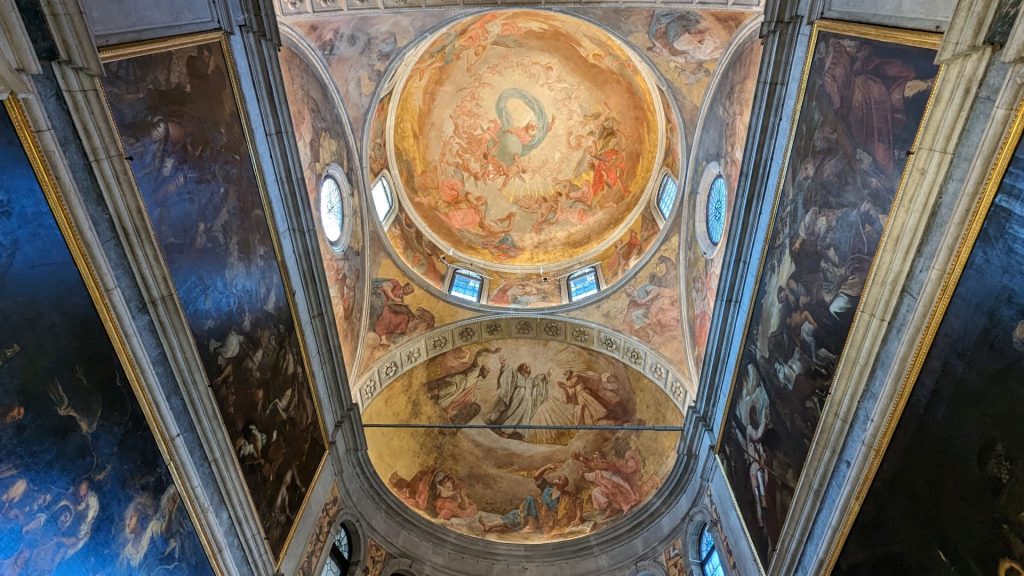
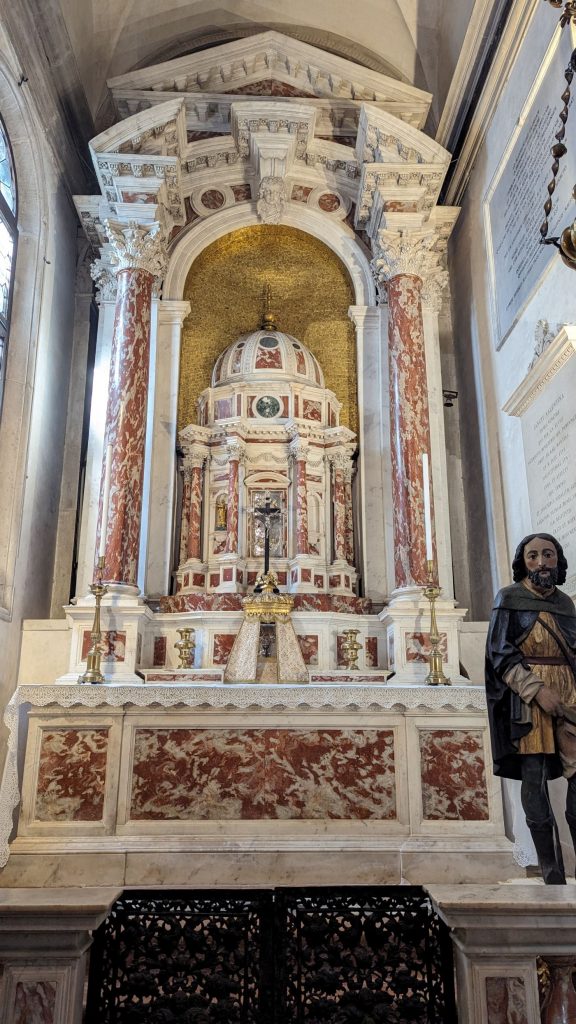
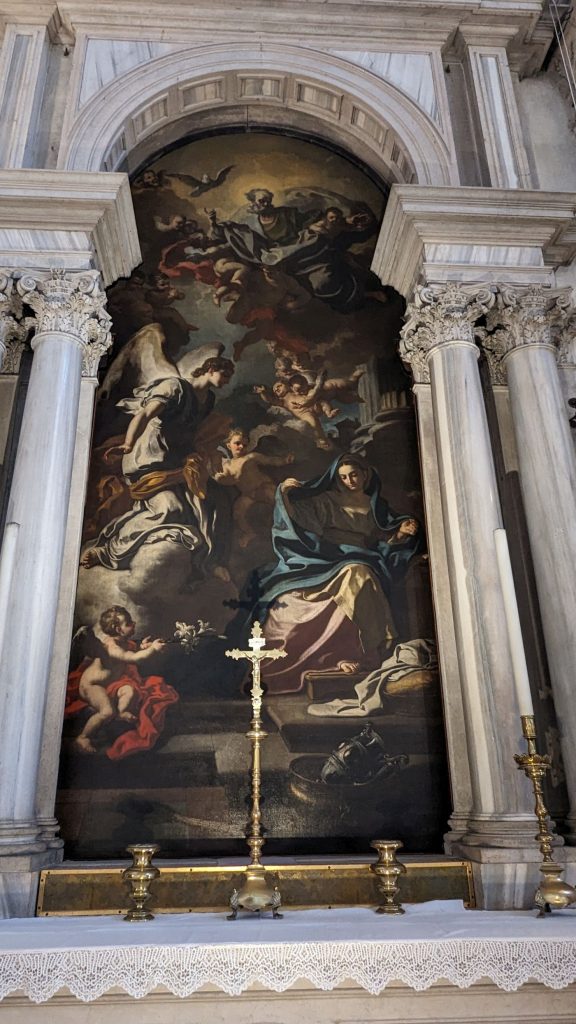
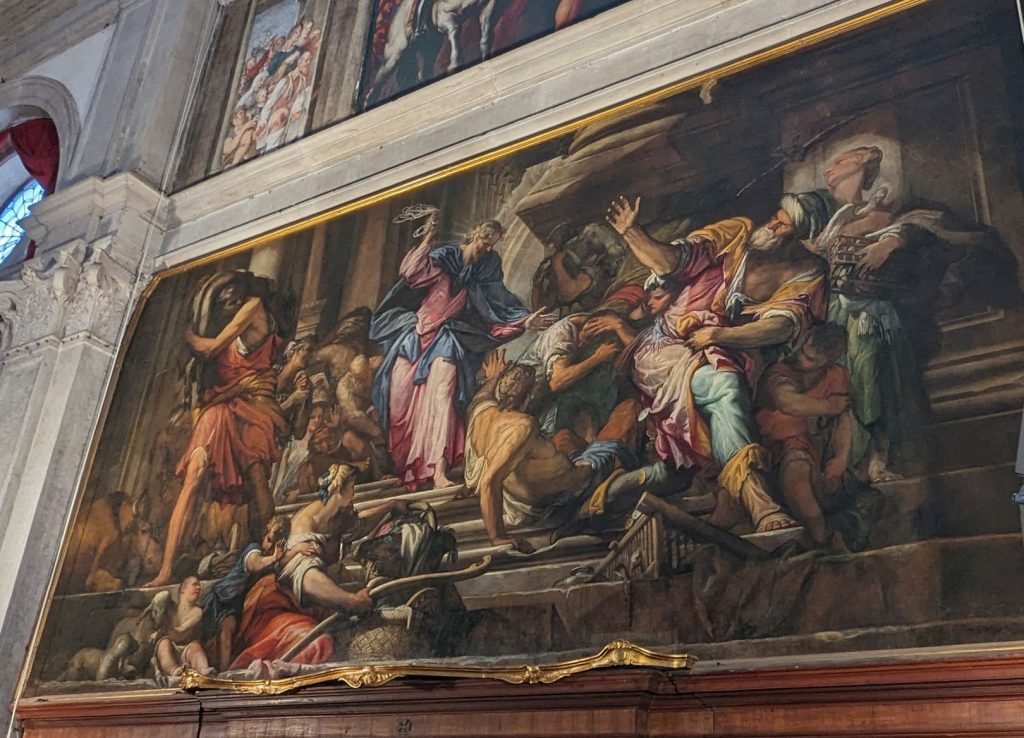
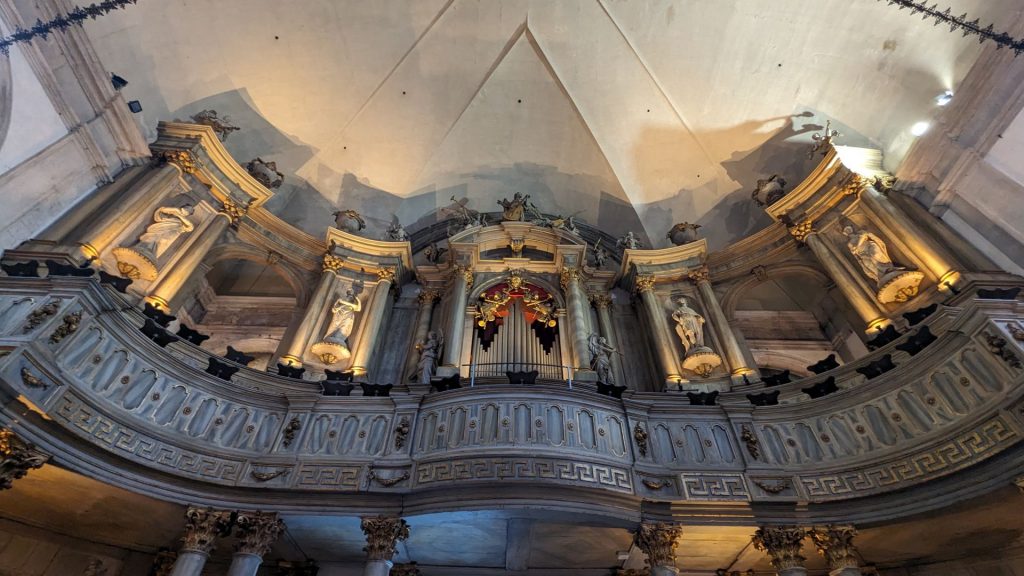
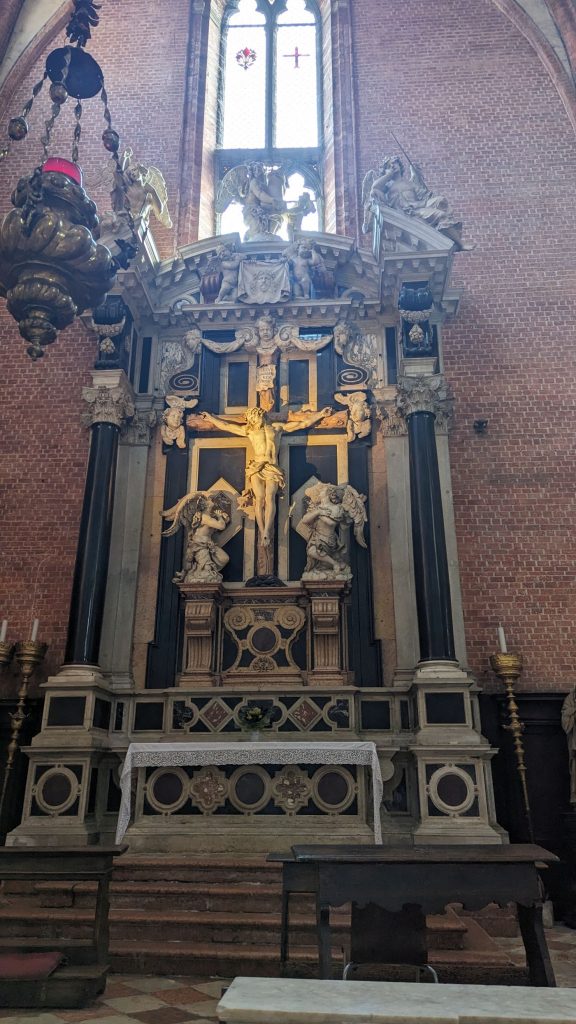
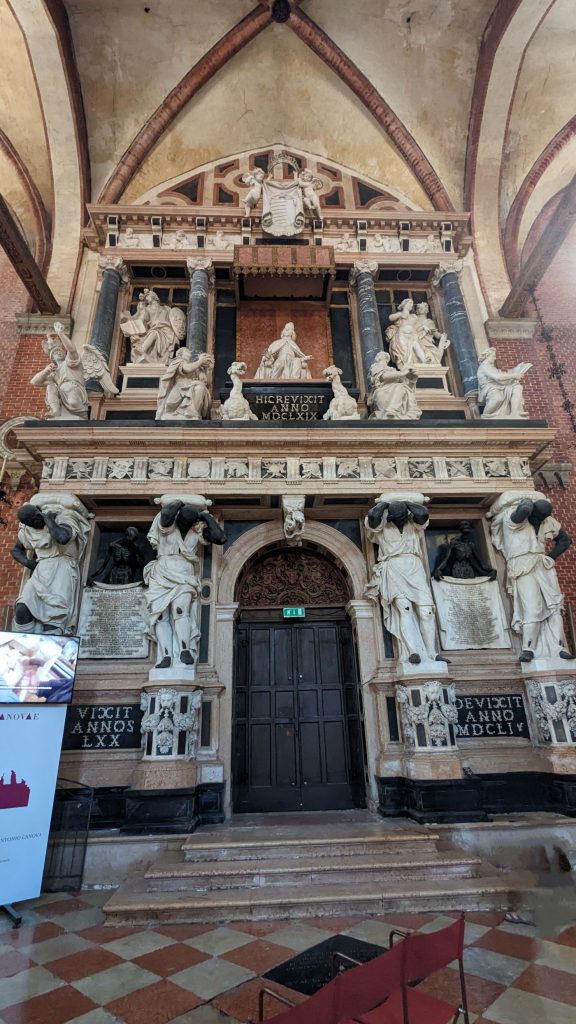
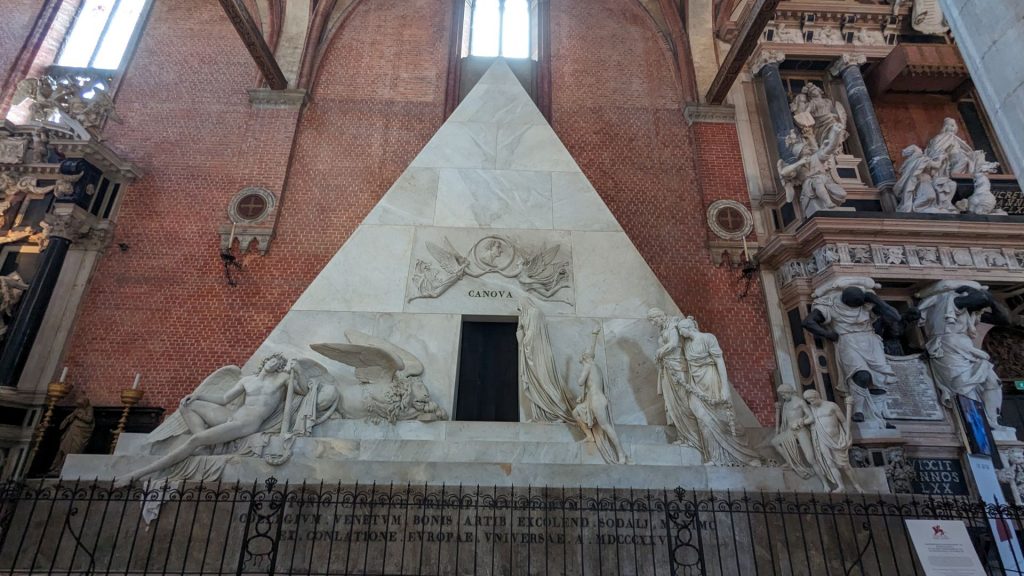
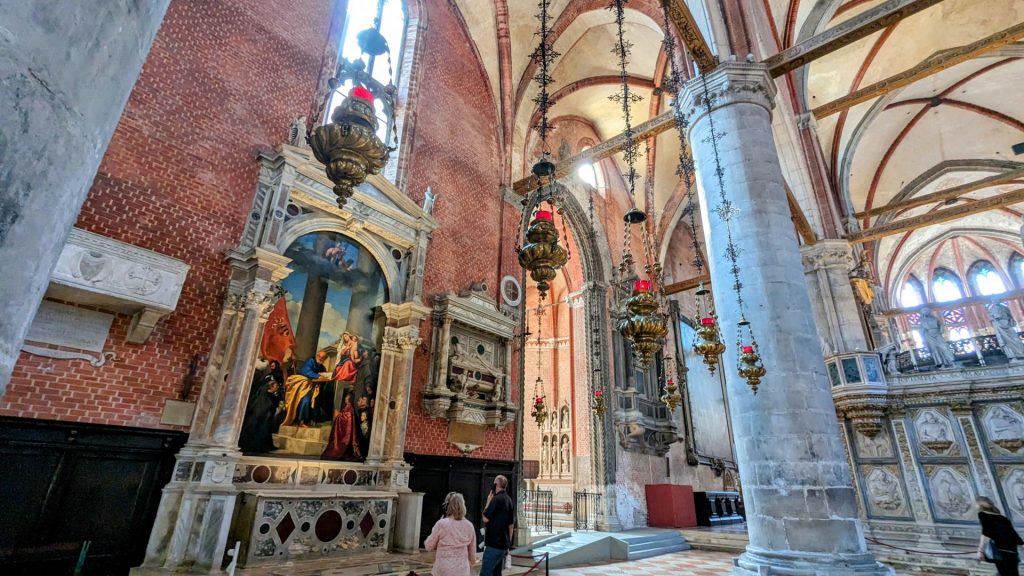
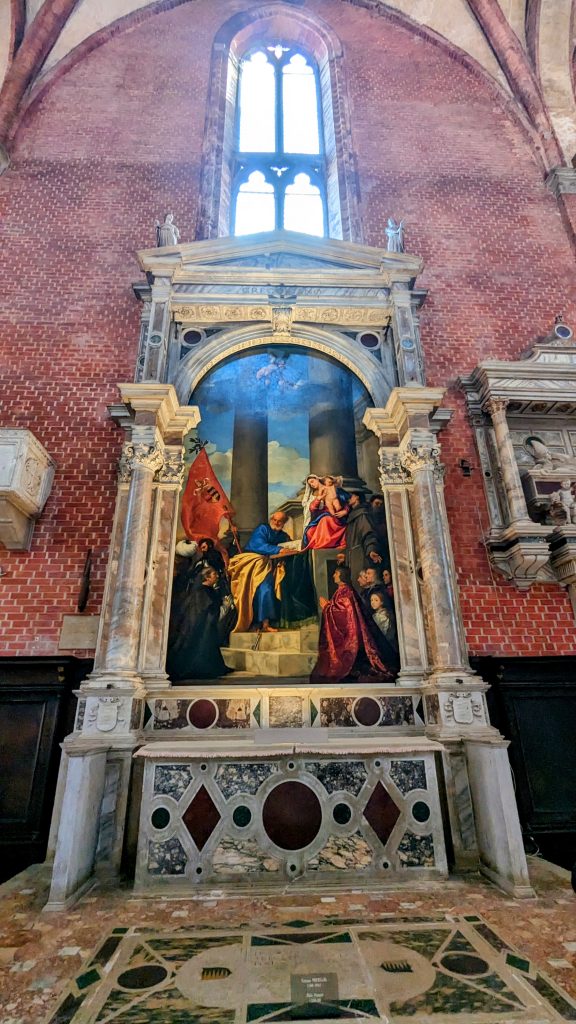
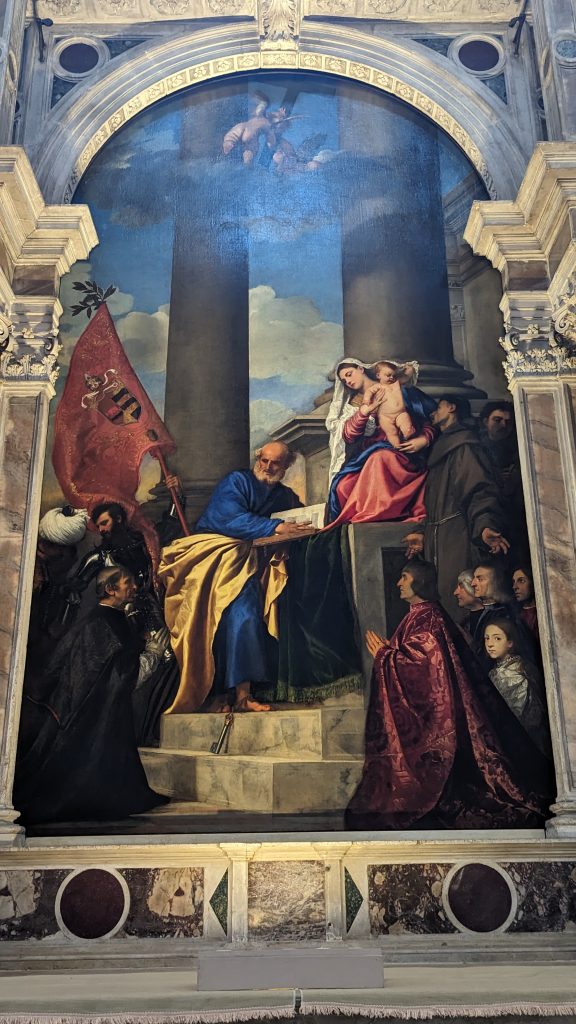
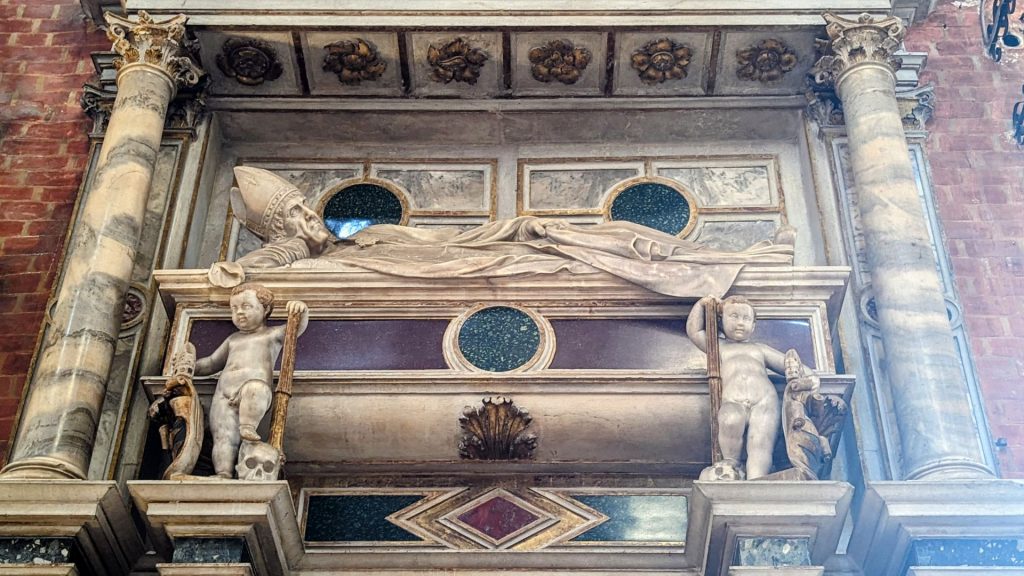
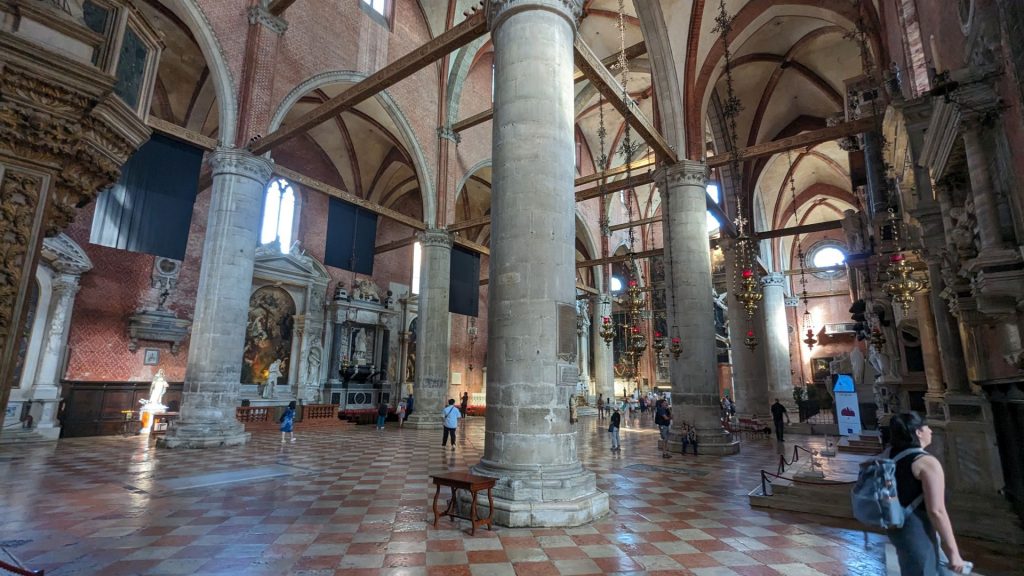
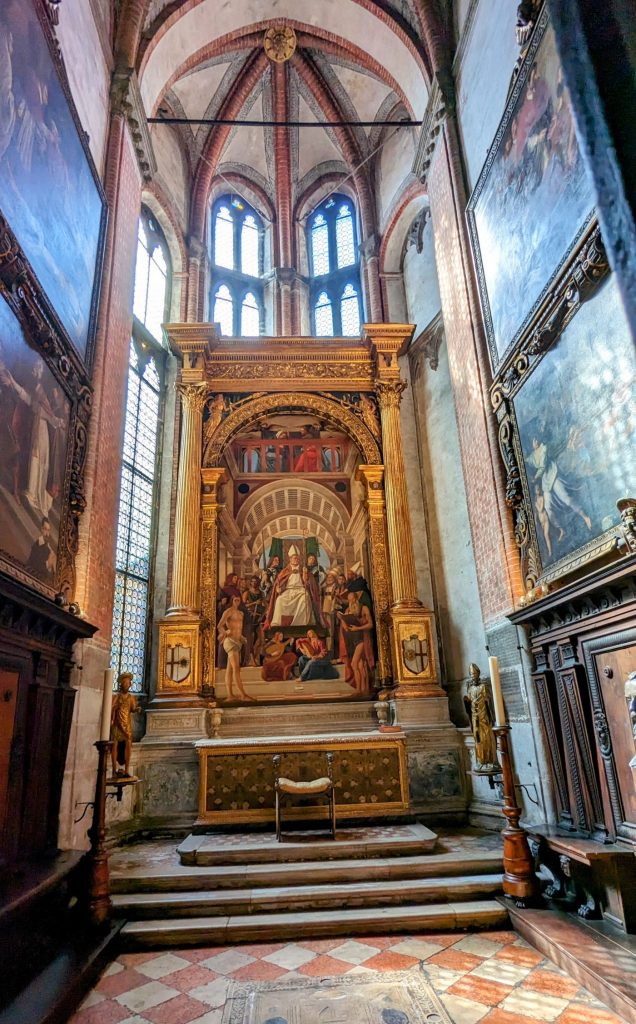
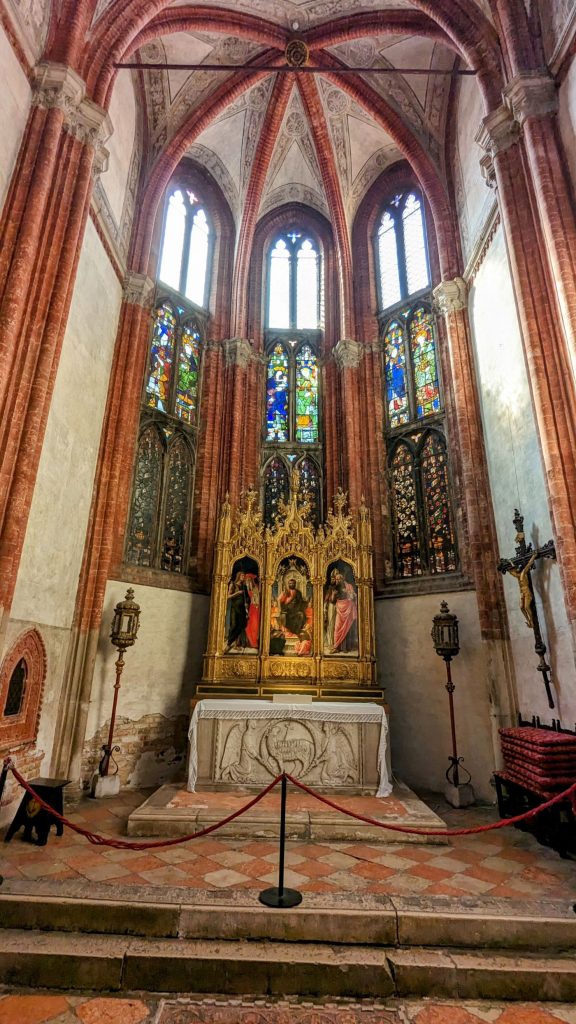
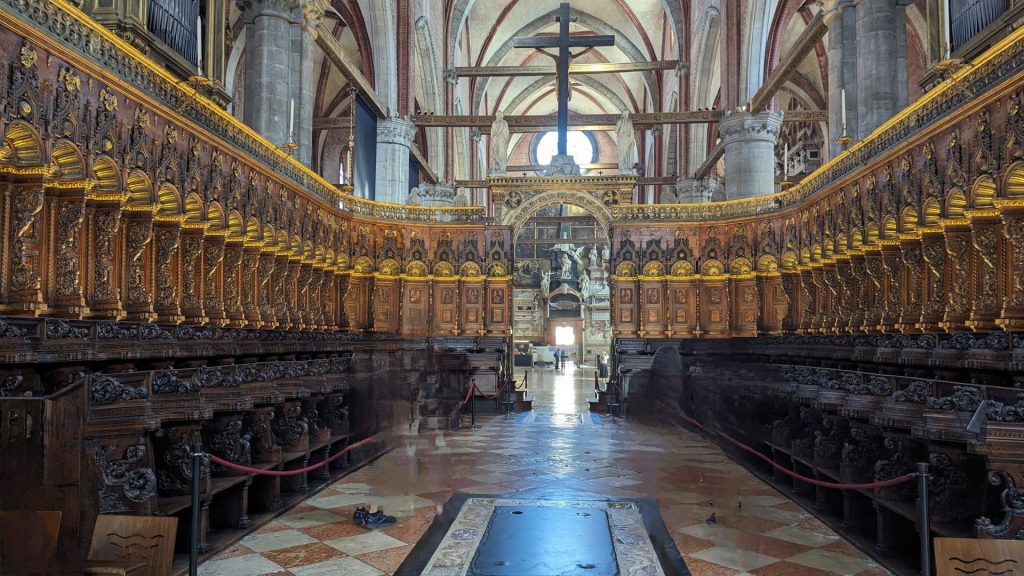
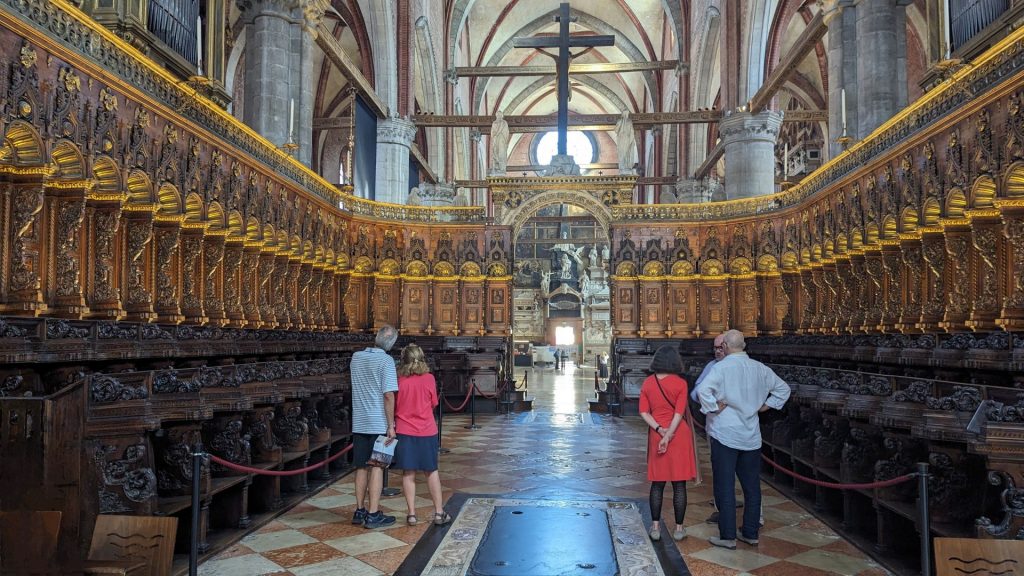
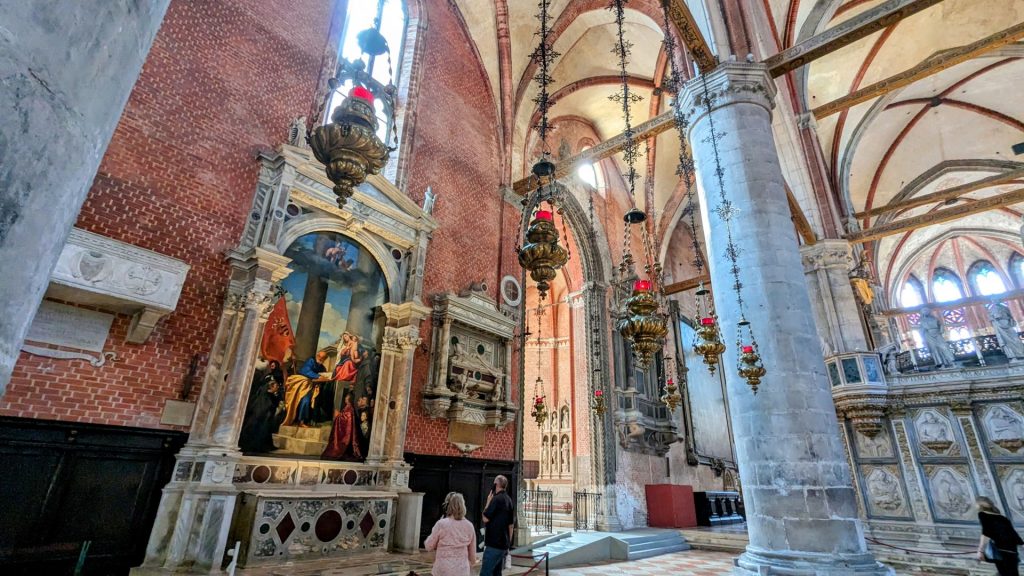
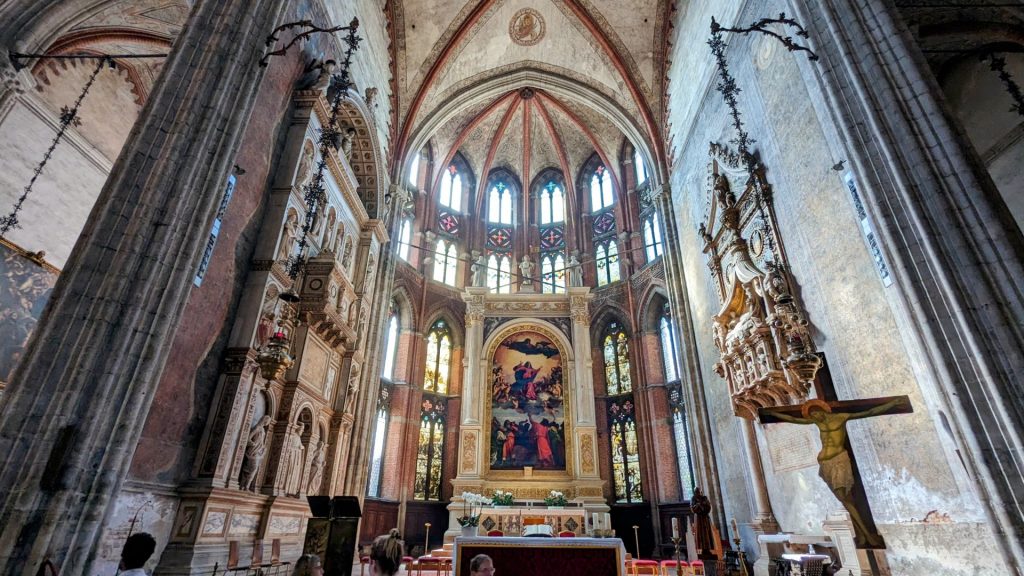
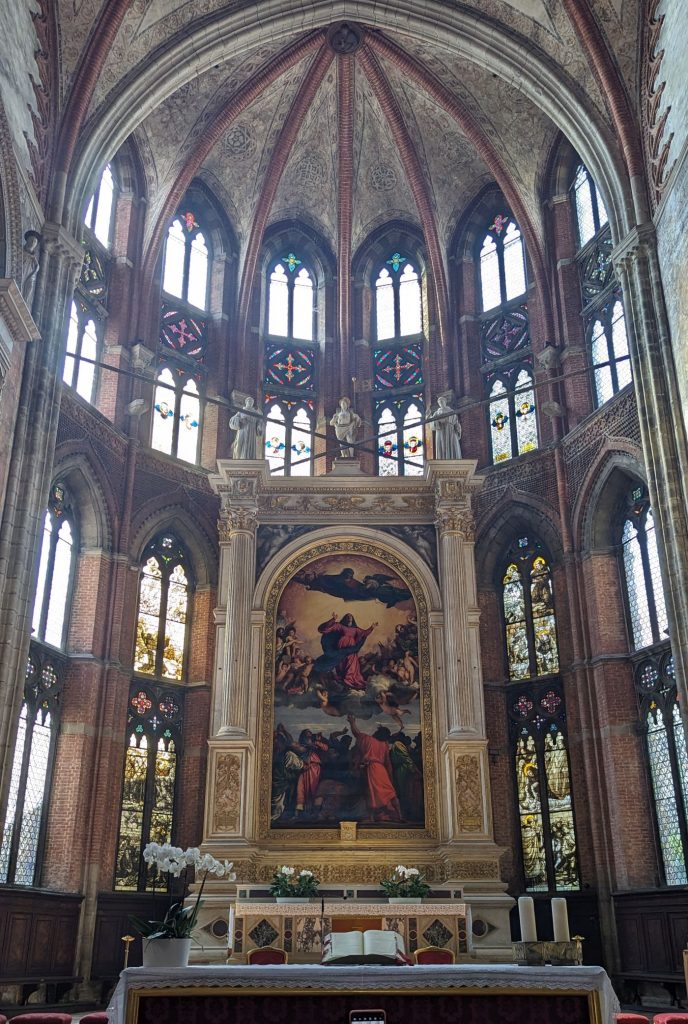
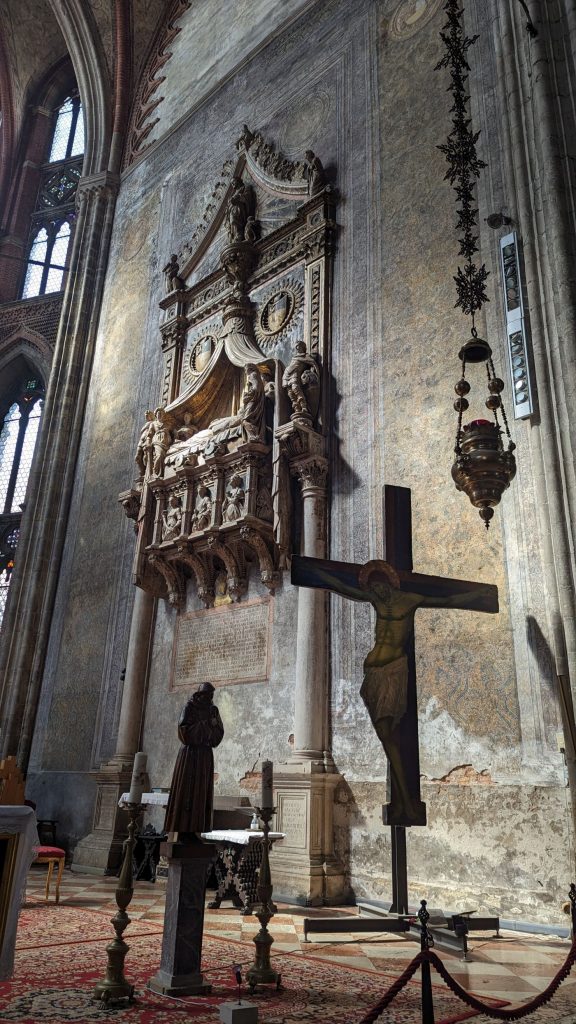
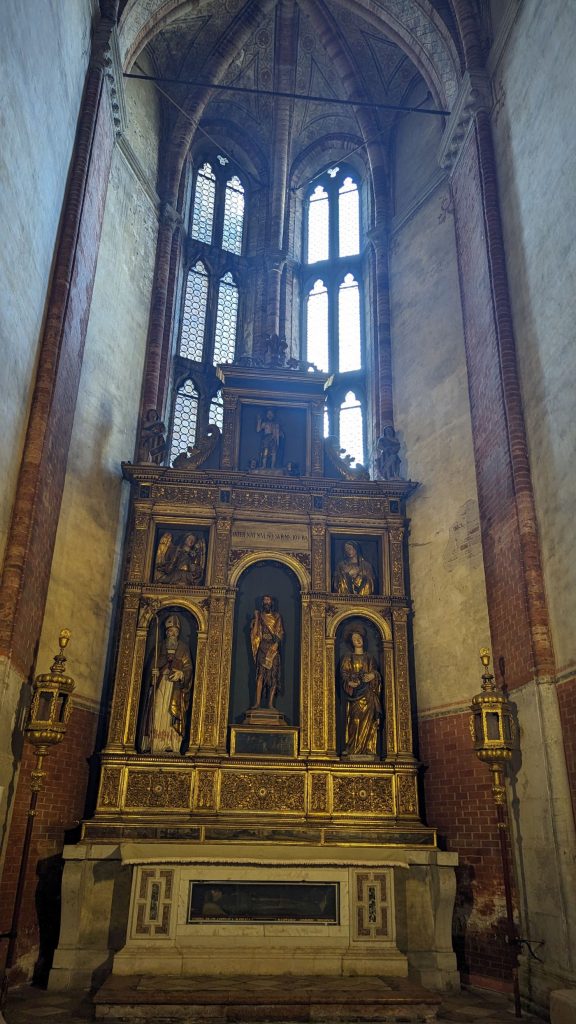
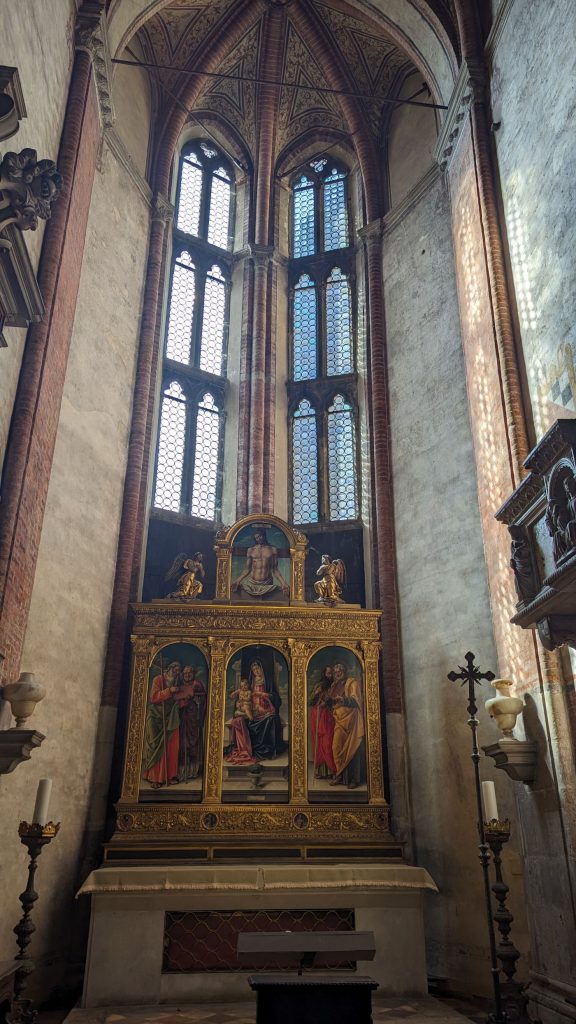
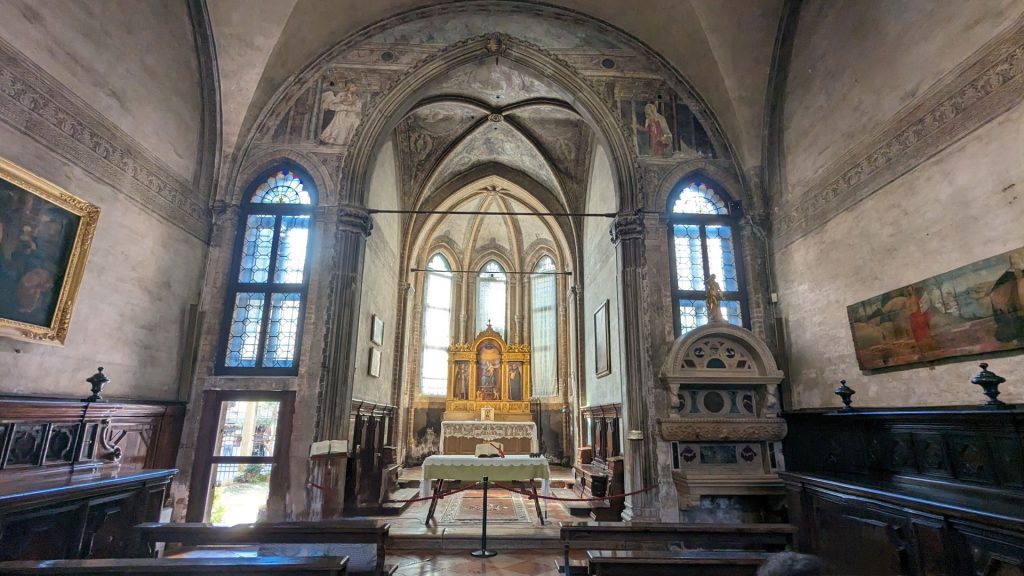
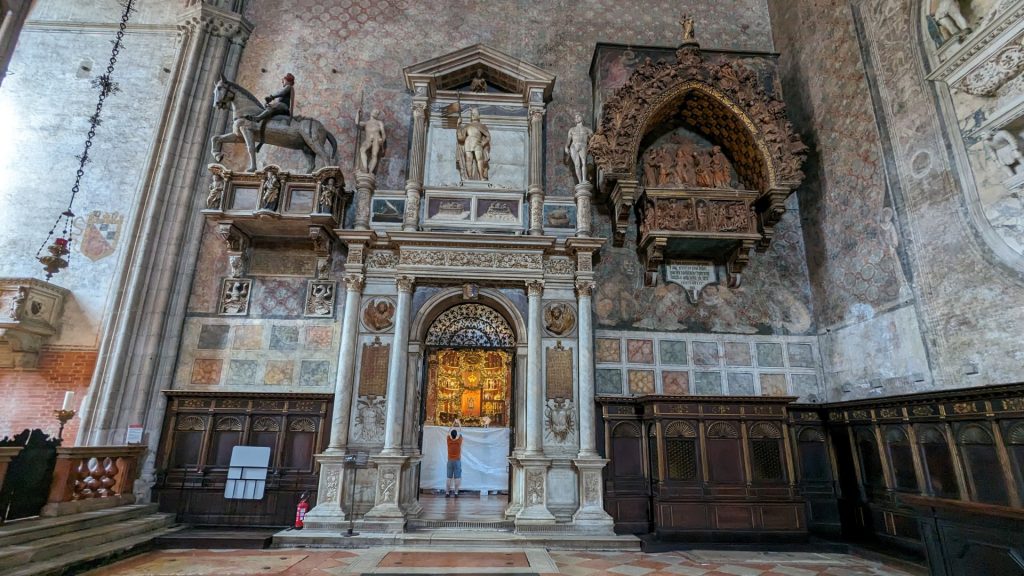
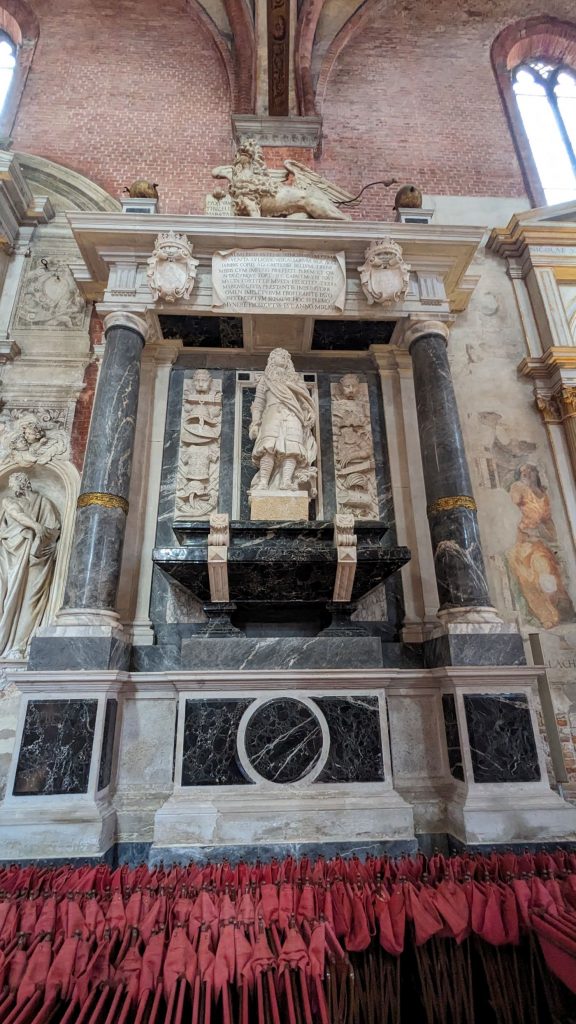
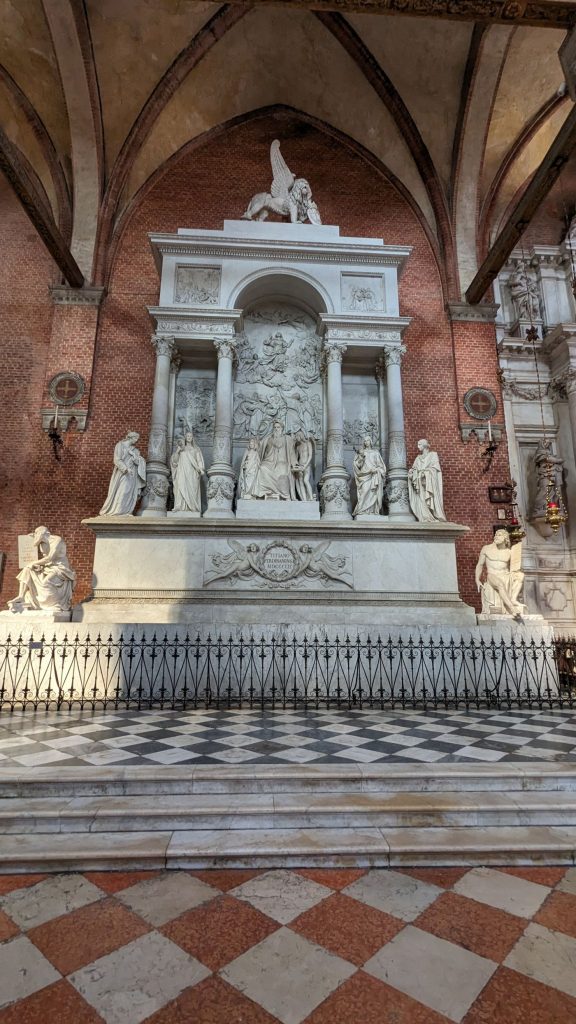
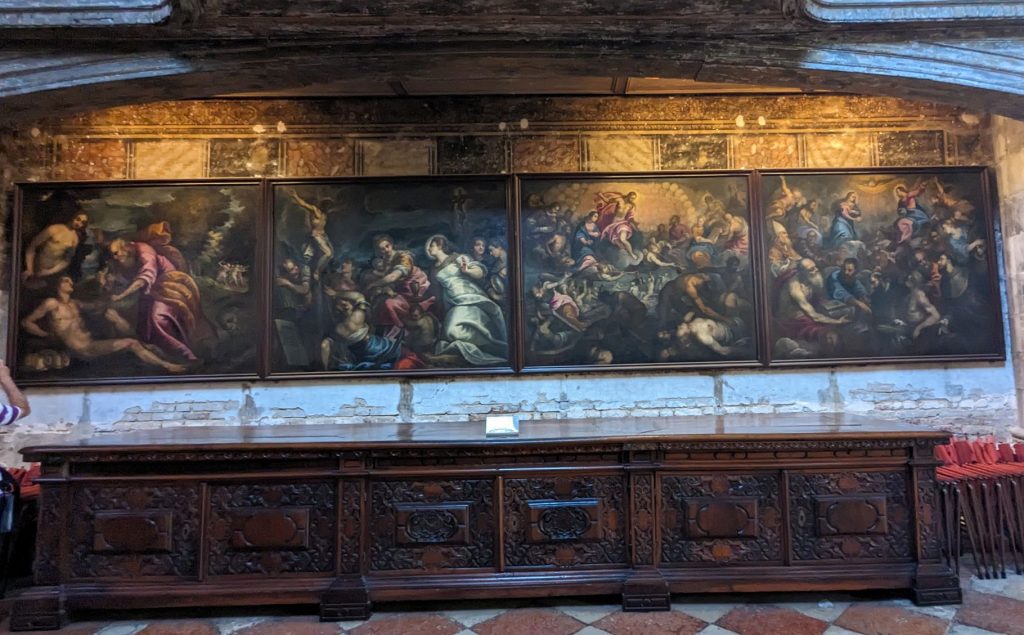
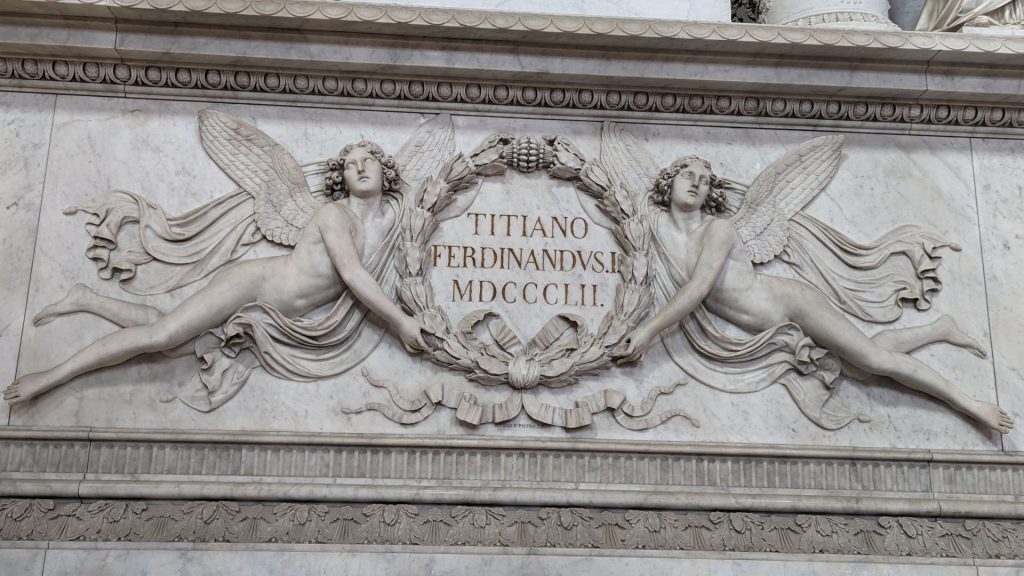
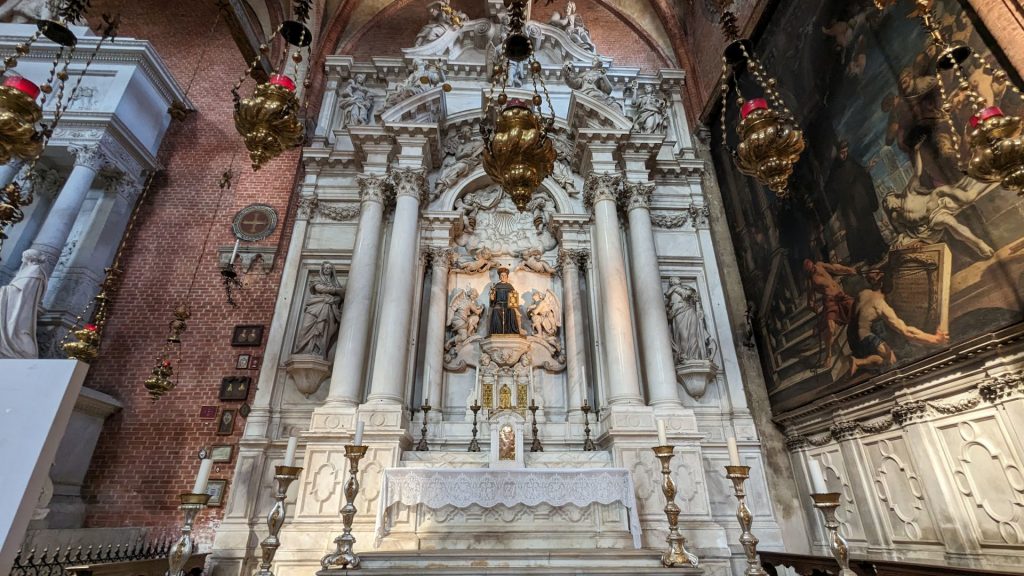
And now it was time for a glass of wine and a snack. We went to the Cantina do Mori. Founded in 1492, it is the oldest wine bar in Venice!
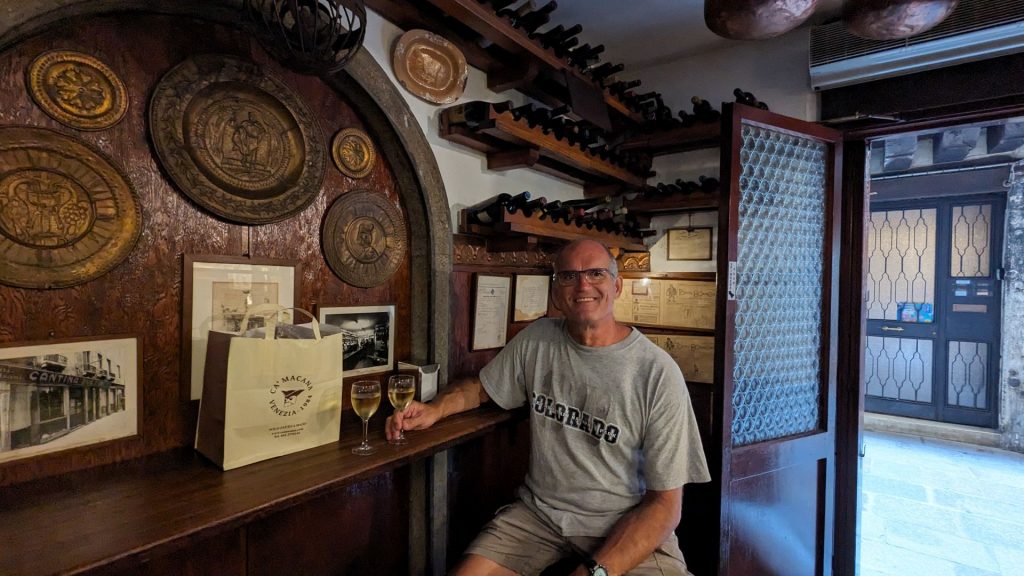
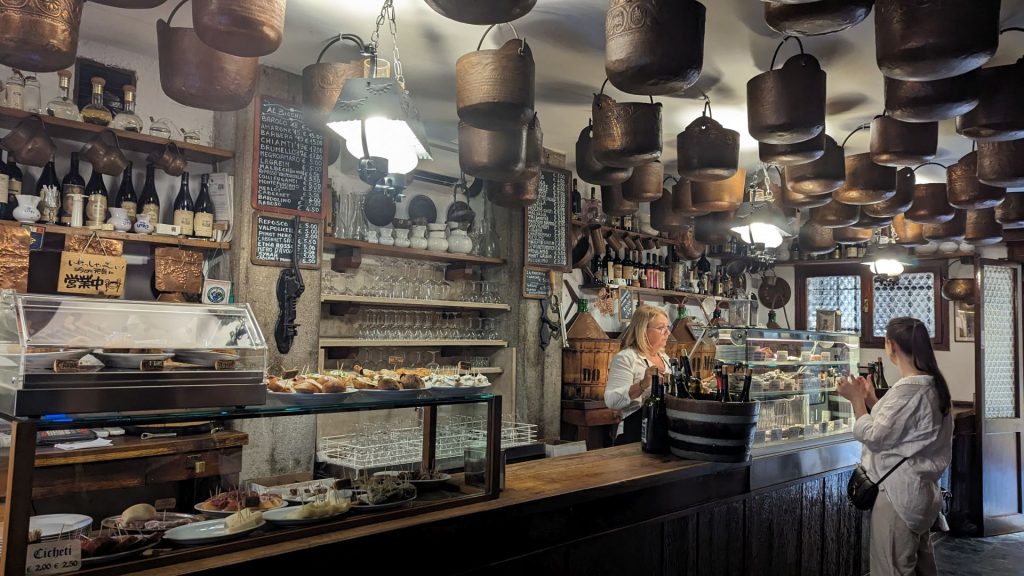
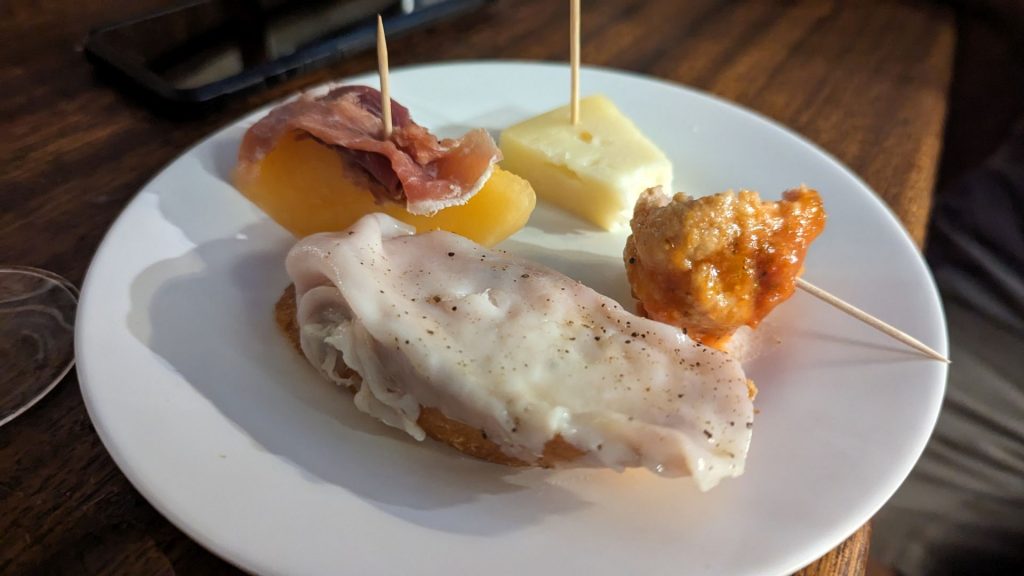
Our second day in Venice was coming to a close. What a joy it was to simply walk around, view the buildings, watch the people, enjoy the canals both grand and small. Venice is the perfect walking city!
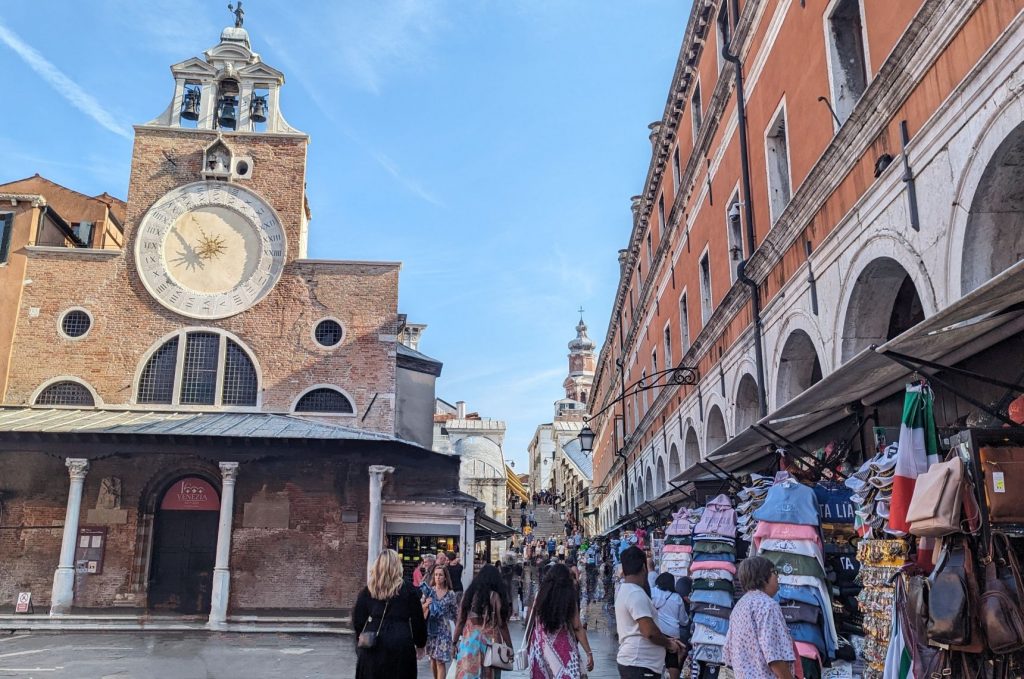
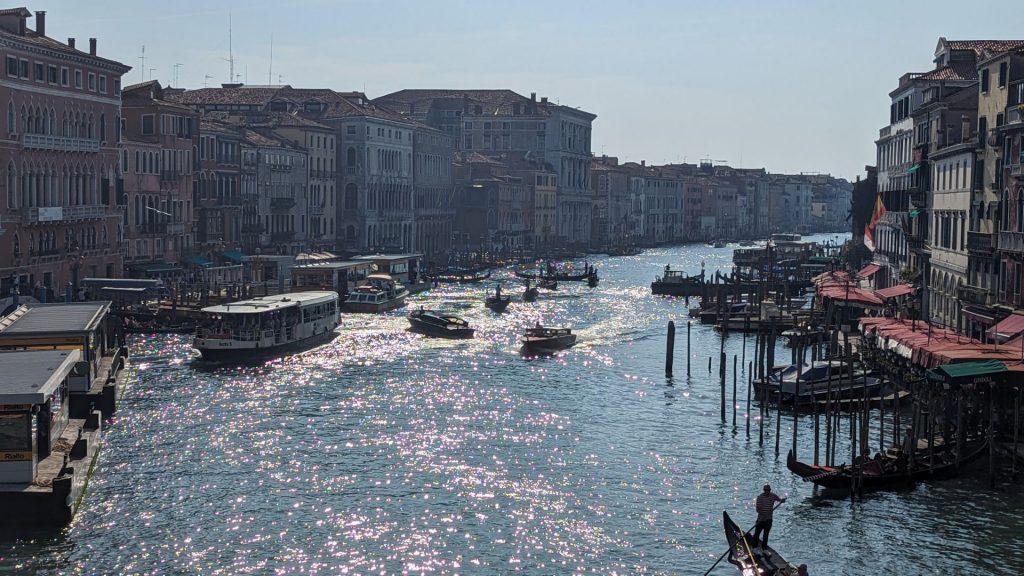
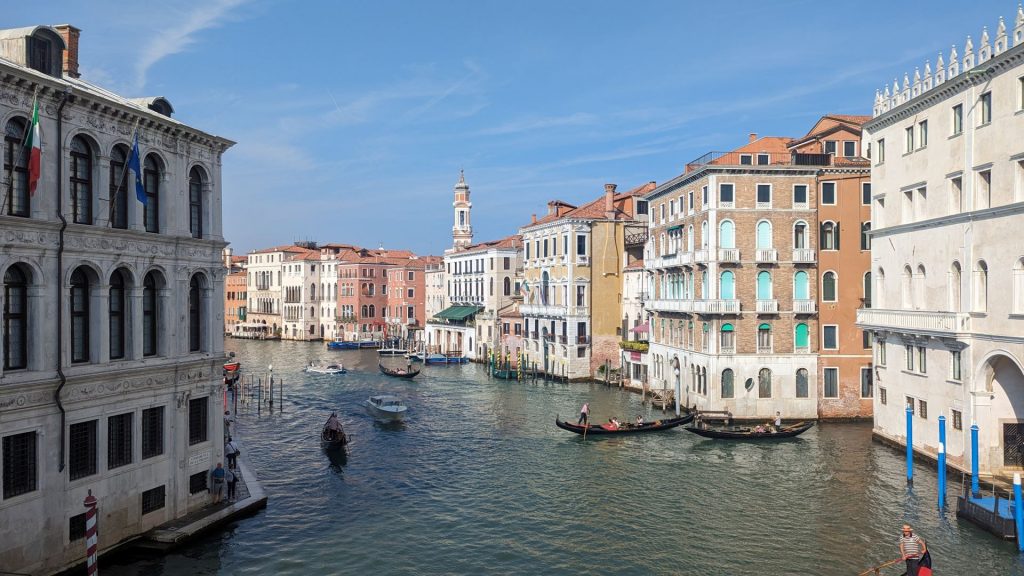
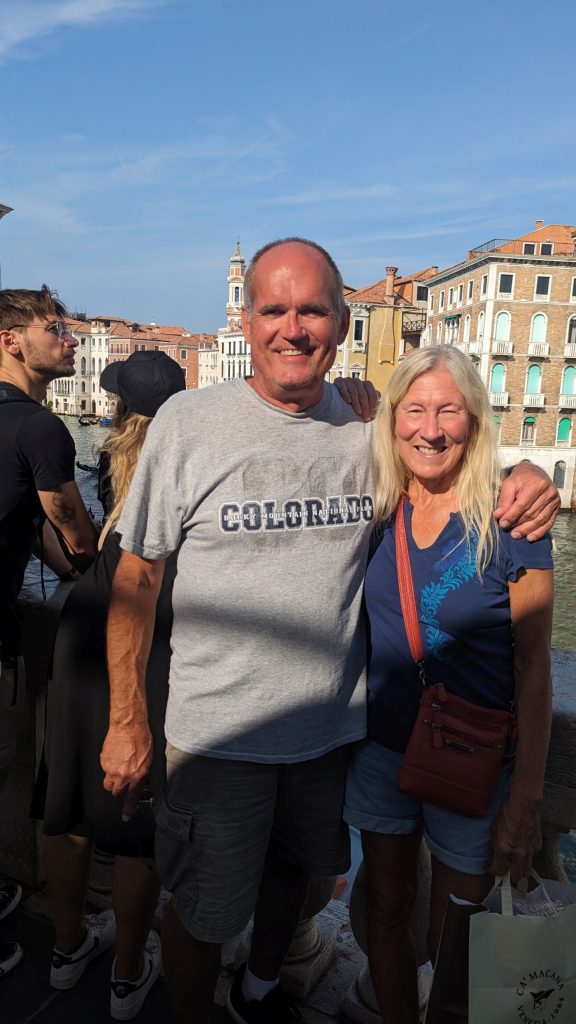
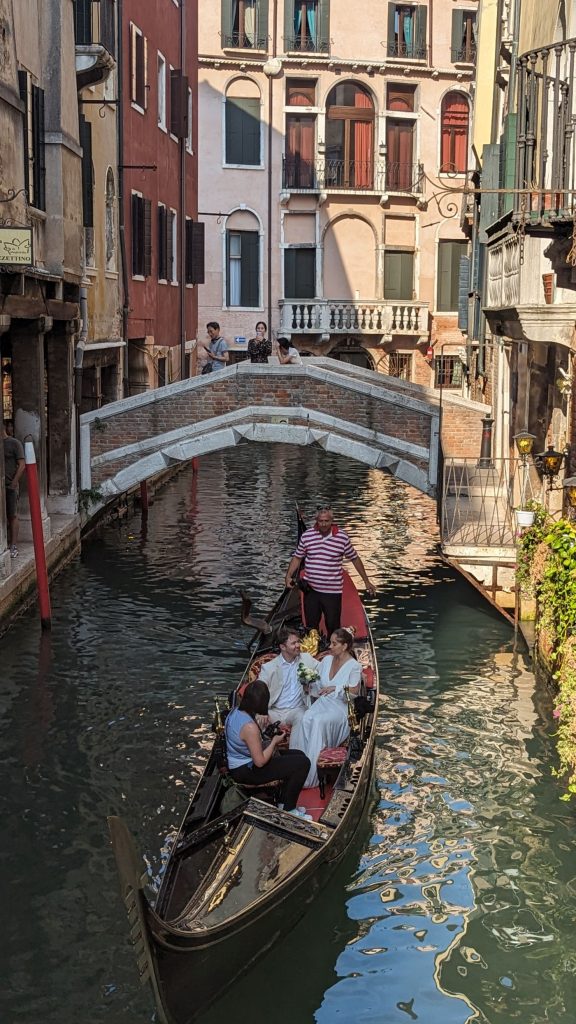
We got up early the next day to take the waterbus to the train station. We enjoyed one last trip on the Grand Canal.
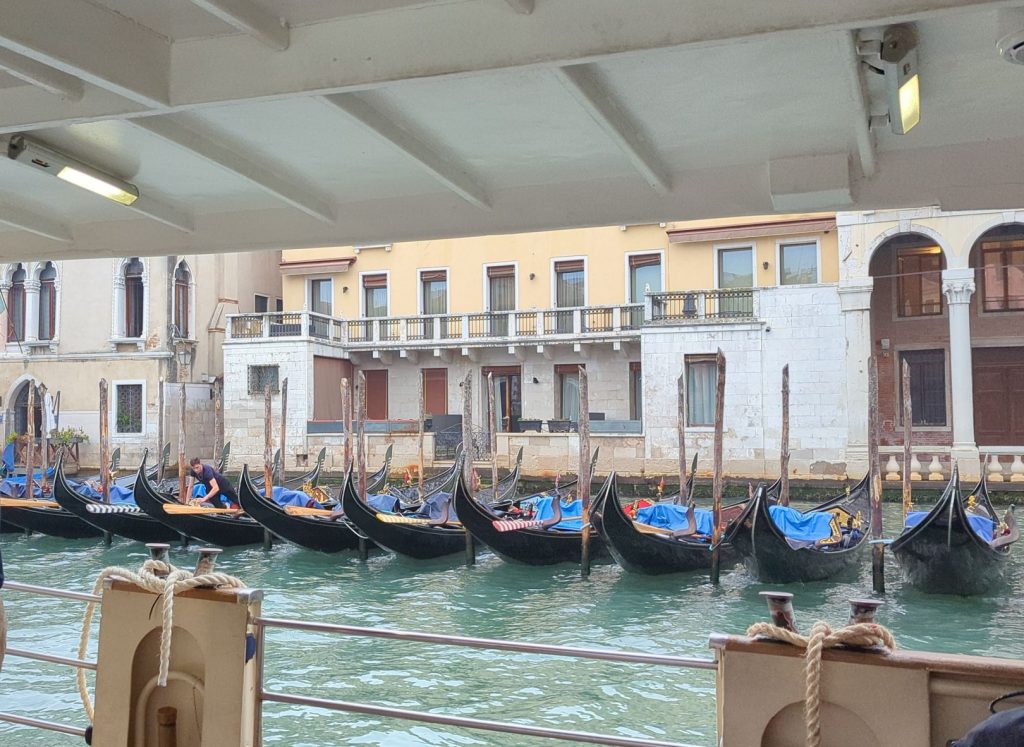
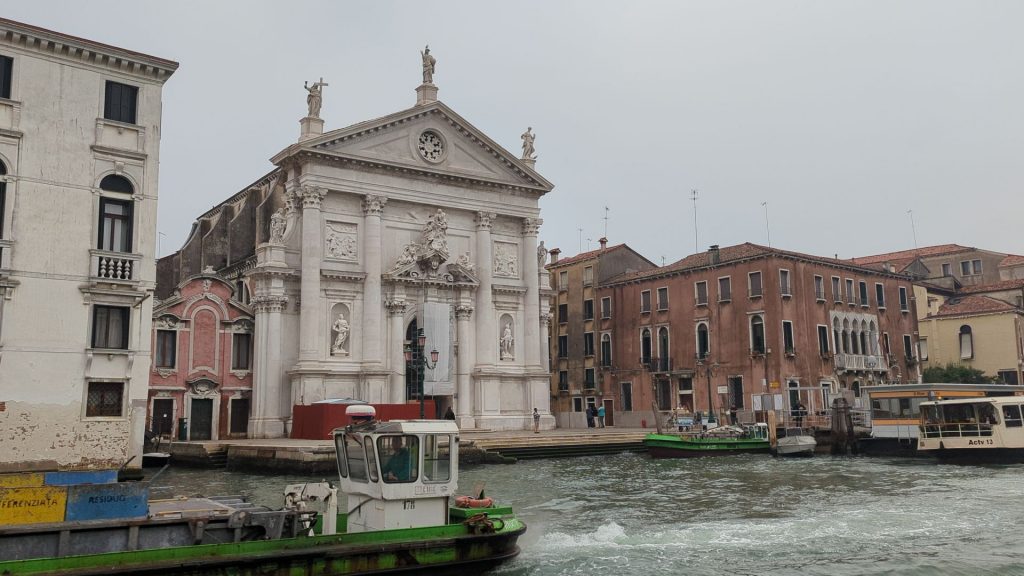
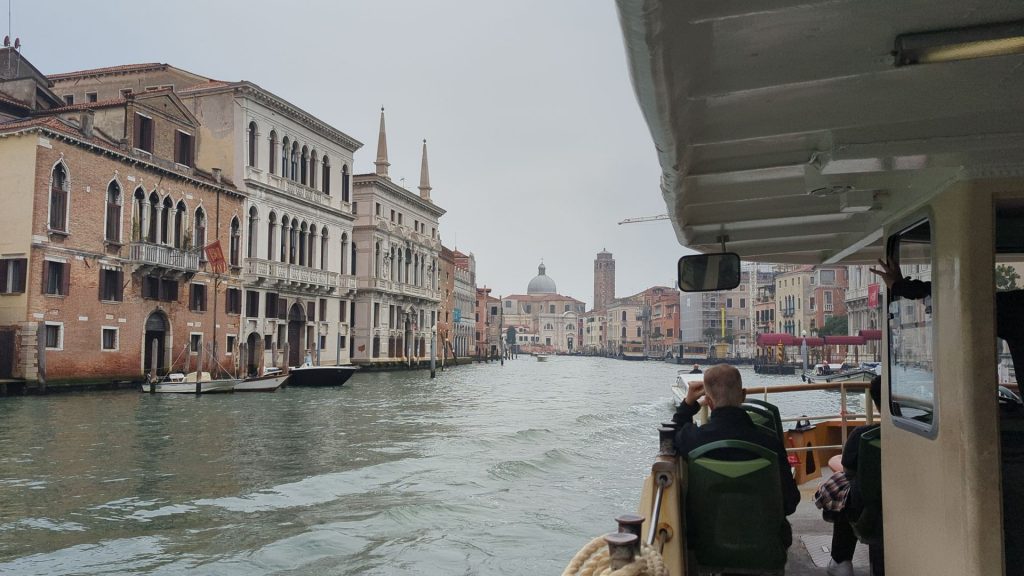
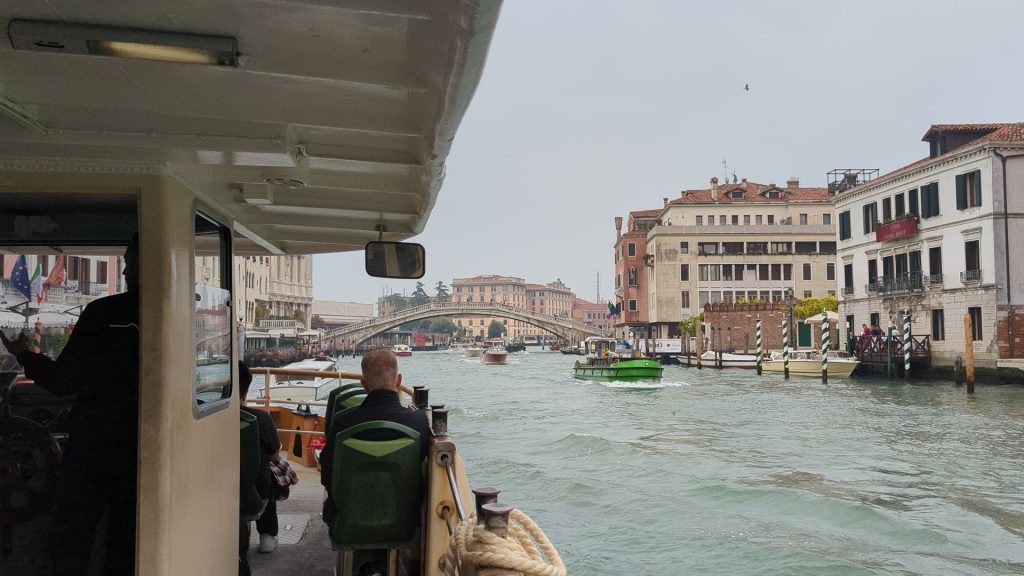
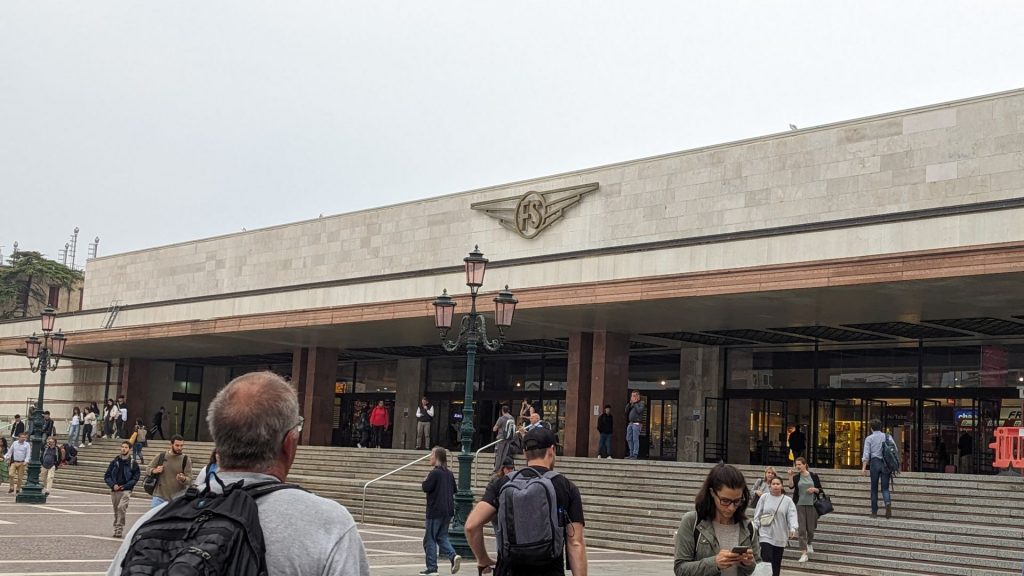
Cinque Terre, here we come!
